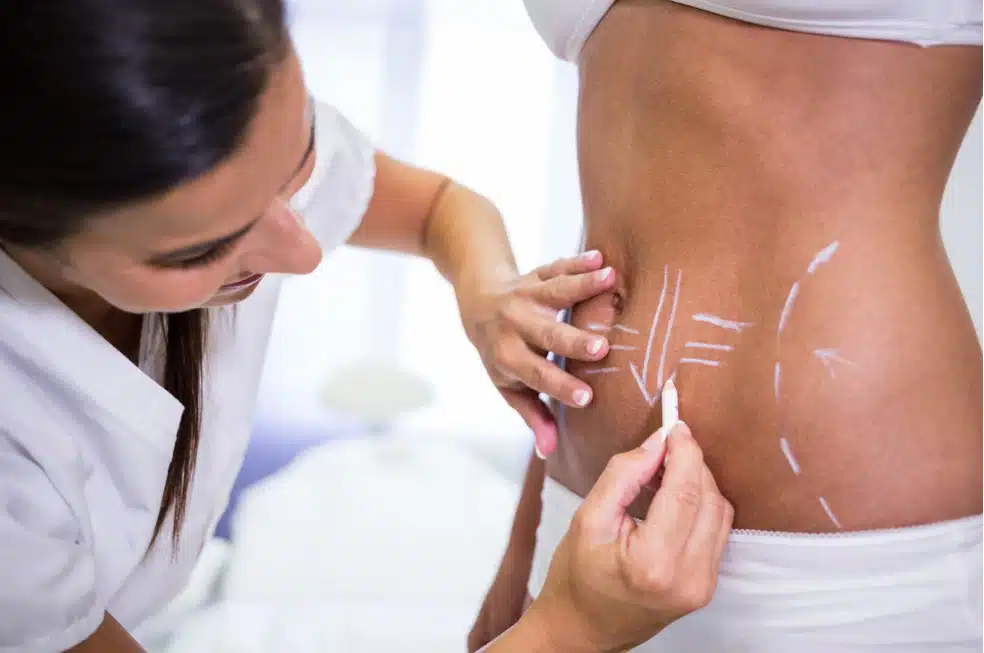Liposuction costs can range anywhere from $5,000 to well over $20,000—but why such a vast difference? The answer lies in the procedure. Not all liposuction is equal, and the type of technology your surgeon uses plays a significant role in determining your final bill. Traditional tumescent liposuction can range from $ 2,000 to $5,000 per area, while newer technologies, such as VASER (ultrasound) or SmartLipo (laser), can range from $5,000 to $10,000 or more for the same area. The American Society of Cosmetic Surgeons has estimated the average cost of a liposuction procedure to be $4,711; however, this does not account for anesthesia fees, facility fees, or the specific method used. Here, we will compare the price differences among some of the most popular liposuction treatments—tumescent, laser liposuction, ultrasound-assisted liposuction, power-assisted liposuction, and more—so that you can better understand the reasons behind the price differences and make an informed decision about which approach is the most cost-effective for your body contouring goals.
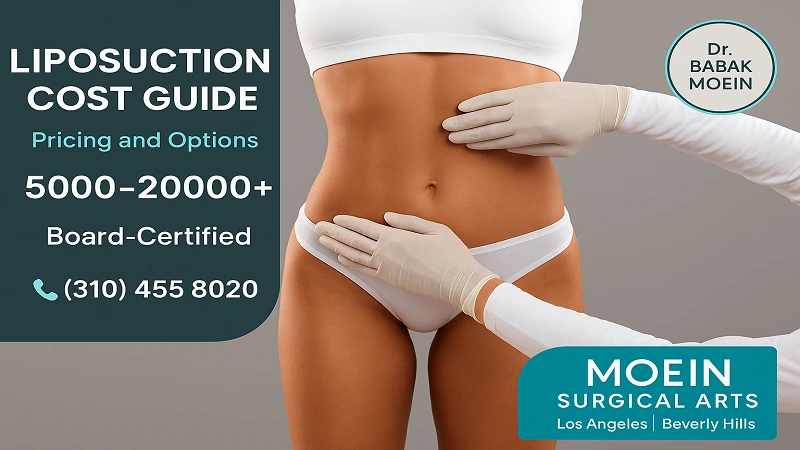
What Affects the Cost of Liposuction?
Your final liposuction bill isn’t one flat rate—several key factors shape it:
- Number of treatment areas – One zone vs. multiple areas in a single session
- Surgeon’s experience and credentials – Board certification and years of specialized training
- Technique used – Traditional, laser-assisted, VASER, or high-definition sculpting
- Geographic location – Urban centers cost more than smaller cities
- Anesthesia type – Local vs. general anesthesia
- Facility fees – Accredited surgical center vs. hospital operating room
- Case complexity – Your skin quality, previous surgeries, and overall health
- Additional procedures – Combining lipo with tummy tuck, BBL, or body contouring
We’ll break down each of these in detail below, including real price ranges and what you’re actually getting for your money.
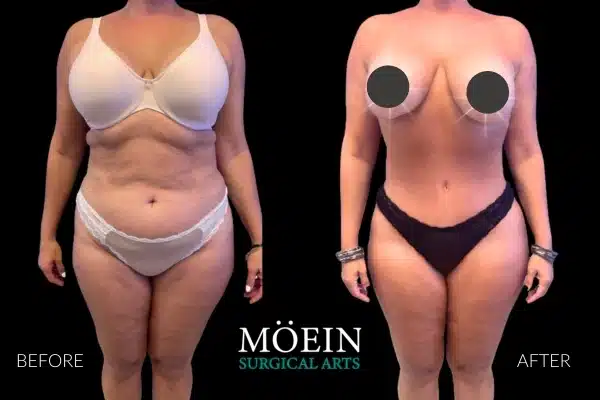
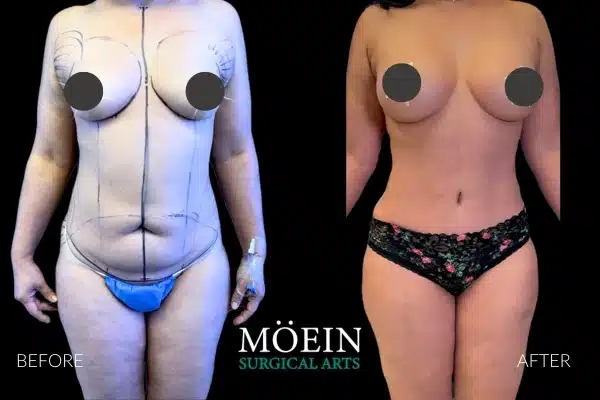
Liposuction Techniques Cost Comparison
The most significant determining factor for your liposuction expense is the method your surgeon selects. Although time-tested traditional tumescent liposuction has been the standard for many years, newer technologies, such as laser-assisted, VASER, and high-definition sculpting, bring their own advantages, including quicker turnaround times and more pronounced muscle definition. The caveat? The caveat is that advancements in techniques generally translate into pricier expenses. Here, we’ve compared the most prevalent methods of liposuction against one another, so you know exactly what you’re paying for:
| Technique | Cost Range | Recovery Time | Best For | Technology |
|---|---|---|---|---|
Traditional/Tumescent Budget-Friendly | $2,000 – $5,000 | 1-2 weeks | Larger fat volumes, multiple areas, proven results | Manual suction with tumescent solution |
Mini Liposuction Most Affordable | $1,500 – $4,000 | 3-7 days | Small, localized areas (chin, knees, arms) | Local anesthesia, minimal invasiveness |
Laser-Assisted (SmartLipo) Popular Choice | $3,000 – $7,500 | 1-2 weeks | Skin tightening, smaller areas, faster healing | Laser fiber melts fat + tightens skin |
Power-Assisted (PAL) Efficient | $3,500 – $8,000 | 1-2 weeks | Dense fat, multiple areas, even results | Motorized vibrating cannula |
Ultrasound-Assisted (UAL) Advanced | $4,000 – $9,000 | 1-3 weeks | Fibrous areas (back, male chest), revision cases | Ultrasonic waves liquefy fat cells |
VASER Liposuction Premium | $4,500 – $10,000 | 1-2 weeks | Precision contouring, less bruising, smooth results | Advanced ultrasound, tissue-selective |
High-Definition (HD Lipo) Elite Option | $8,000 – $20,000+ | 2-4 weeks | Athletic definition, visible abs, muscle sculpting | VASER + artistic muscle etching |
Here’s how the popular options stack up side-by-side when it comes to results, recovery, and real-world outcomes.
How Surgeon Experience Affects Liposuction Cost in Los Angeles?
Get real, you’ll see surgeons quoting $3,000 and some quoting $12,000 for procedures of the same kind. Why? Experience, credentials, and know-how. A board-certified cosmetic surgeon who has undergone extensive specialty training is likely to charge more because they can achieve a natural look, minimize complications, and provide a lasting result. Making your decision based solely on cost may result in poor outcomes, necessitating repairs or even severe complications that require a significant financial investment to rectify.
At Moein Surgical Arts, you are treated by Dr. Babak Moein, a board-certified cosmetic surgeon with more than 20 years of experience in state-of-the-art body contouring. He is known across Los Angeles and Beverly Hills for being precise, safe, and having performed thousands of successful makeovers.
Average Liposuction Cost by Area – Abdomen, Thighs, Chin & More
Now that you understand the techniques, let’s discuss what you’ll actually pay, based on where you want to receive treatment. Some areas are quick and straightforward, while others require more time, skill, and precision, which naturally affects the price. Here’s what you can expect to invest in for the most commonly treated areas.
| Body Area | Cost Range | Procedure Time | Typical Volume | Often Combined With |
|---|---|---|---|---|
| Abdomen (Upper/Lower) Most Popular | $3,500 – $8,000 | 2-3 hours | 2-4 liters | Flanks, waist |
| Flanks (Love Handles) Popular | $2,500 – $6,000 | 1-2 hours | 1-2 liters | Abdomen, back |
| Thighs (Inner & Outer) | $3,000 – $7,500 | 2-3 hours | 2-3 liters | Hips, knees |
| Upper Arms | $2,500 – $5,500 | 1-2 hours | 0.5-1 liter | Back, bra line |
| Back & Bra Line | $3,000 – $6,500 | 1.5-2.5 hours | 1-2 liters | Flanks, arms |
| Buttocks | $3,000 – $7,000 | 2-3 hours | 1-3 liters | BBL, thighs |
| Hips (Saddle Bags) | $2,500 – $6,000 | 1.5-2 hours | 1-2 liters | Thighs, flanks |
| Male Chest (Gynecomastia) | $4,000 – $8,000 | 2-3 hours | Varies | Gland removal |
| Chin & Neck (Submental) Popular | $2,000 – $4,500 | 1 hour | 0.2-0.5 liters | Neck lift, facelift |
| Knees (Inner) | $1,800 – $4,000 | 1 hour | 0.3-0.5 liters | Thighs, calves |
| Ankles & Calves | $2,500 – $5,500 | 1.5-2 hours | 0.5-1 liter | Knees, thighs |
| 360-Degree Lipo (Full Torso) Package Deal | $8,000 – $18,000 | 3-5 hours | 4-8 liters | Complete transformation |
What is the cost of liposuction near me?
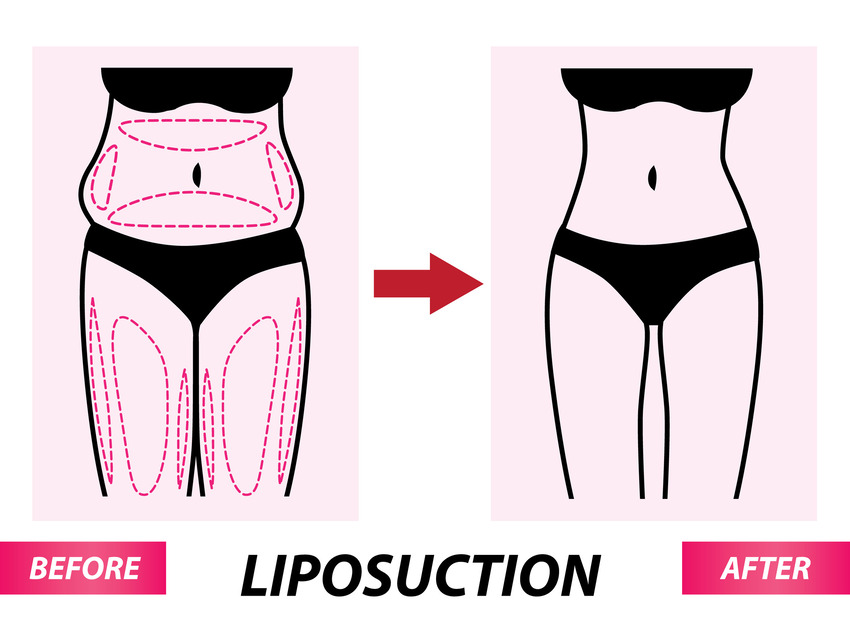
Where you get your liposuction significantly impacts the cost. Procedures in Los Angeles, Beverly Hills, or Manhattan cost more than in smaller cities, not because of the quality, but due to overhead. Rent, staff salaries, and facility costs are higher in major metropolitan areas, and these expenses are ultimately passed on to patients.
However, higher prices in cities like LA often mean access to top-tier surgeons and advanced facilities. At Moein Surgical Arts in Los Angeles, you’re investing in both a premium location and Dr. Moein’s decades of expertise. Choosing surgery based solely on finding the cheapest city can backfire; complications far from home mean limited follow-up care and unfamiliar standards.
| California Region | Typical Liposuction Cost |
|---|---|
| Liposuction Cost Los Angeles | $6,000 – $20,000 |
| Liposuction Cost Beverly Hills | $6,500 – $21,000 |
| Liposuction Cost Orange County | $5,500 – $20,500 |
| Liposuction Cost San Diego | $5,000 – $22,000 |
| Liposuction Cost Inland Empire | $5,000 – $19,000 |
| Liposuction Cost Central Valley | $5,500 – $19,500 |
Awake Liposuction vs. General Anesthesia: How to Decide What’s Right for You
When you choose to have your liposuction awake or with general anesthesia, there are some significant factors that need to be addressed. Your comfort, the amount of locations that you’ll need treated, and your surgical objectives all contribute to finding the optimal choice.
Number of Treatment Areas
- If you want more than a few regions treated, usually more than three, it is generally best to have the procedure conducted under general anesthesia.
- This procedure enables you to achieve more accuracy and efficiency in surgery, but in a manner that you remain comfortable all along.
Anxiety, PTSD, and Medical Conditions
Patients with major anxieties, histories of PTSD, or medical issues that would make them not relaxed or cooperative for surgery should consider having their procedure performed under anesthesia.
These factors can influence your potential to sit still as well as comfortably during awake liposuction.
Cost Considerations
It is one of the benefits of awake liposuction that it is more economical. Not costing as much as a surgery center, anesthesiologist, or specialty nurses, awake procedures have lower overhead. For patients on a lower budget or those having only a small area treated, this can be an appealing option.
High-Definition (HD) Liposuction
If you want high-def or 360° body sculpting, we highly suggest going through general anesthesia.
It involves the application of VASER technology for the removal of fat near the skin or fascia with great accuracy. It involves more pressure and manipulation, hence it is not comfortable when carried out by local anesthesia. Therefore, for high-def liposuction, the patient experiences a more comfortable, effective, and controlled procedure with general anesthesia.
Skin Tightening Procedures
Skin tightening surgeries such as Renuvion (J-Plasma) also do better with general anesthesia. The Renuvion shrinks the skin by means of regulated heat energy, and such heat would most definitely induce discomfort among patients who are awake. Under anesthesia, it is more thoroughly and skillfully carried out by the surgeon.
Fat Grafting and Structural Work
When performing fat grafting into deeper structures (for example, the buttocks, chest, or face), it’s safest and most effective to do so under anesthesia. This permits the exact placement of fat and for patient ease, with no constraint that is associated with being awake.
Summary: Who Is a Good Candidate for Awake Liposuction?
Awake liposuction is a good option for patients who:
Are on a limited budget
Wish to treat one to three small areas
Have minimal anxiety
Are in good overall health
For patients seeking more extensive body contouring, high-definition results, or skin tightening with Renuvion, general anesthesia remains the preferred and safest approach.
Mini Lipo
Traditional Lipo
VASER Lipo
HD Lipo
Does Insurance Cover Liposuction in Los Angeles?
Almost never. Insurance treats liposuction as cosmetic, meaning you pay out of pocket. The rare exception: medically necessary cases like lipoma removal or severe gynecomastia causing physical pain. You’ll need extensive documentation, so don’t count on it.
Your Payment Options
Good news, you don’t need the full amount upfront. Most practices offer financing that spreads payments over months or years. Compare your options below and choose what works for your budget.
Smart Money Tips:
- Ask for total out-the-door pricing (no surprises)
- Look for package deals when treating multiple areas
- Inquire about seasonal promotions
- Consider year-end timing if you have expiring FSA funds
At Moein Surgical Arts, we work with you to find a payment plan that suits your needs. Cost shouldn’t stop you from feeling confident in your body.
| Financing Option | Typical Rates/Terms | Best For | Watch Out For |
|---|---|---|---|
| Cherry | 0% interest options, flexible monthly payments | Fast approval, no hard credit check, pay over time | Shorter terms for some applicants |
| CareCredit | 0% for 6-24 months, then 26%+ APR | Quick approval, widely accepted | High interest after promo period |
| Prosper Healthcare | 7.95-35.99% APR, up to $35,000 | Fixed rates, predictable payments | Rates vary by creditworthiness |
| In-House Payment Plans | Low/no interest, 3-12 months | No credit check often required | Shorter terms, limited availability |
| Personal Bank Loan | 6-20% APR depending on credit | May offer better rates if credit is excellent | Harder approval process |
| 0% Intro APR Credit Card | 0% for 12-21 months, then 18-25% | No interest if paid off in time | Must pay off before promo ends |
Hidden Costs You Need to Know About
That price quote your surgeon gives you? It’s not the whole story. Here are the extras that can catch you off guard:
Facility Fees: $800-$2,500 for surgical center use (hospitals cost even more)
Anesthesia: Already covered this, but it’s billed separately—don’t forget it
Pre-Op Testing: $200-$500 for bloodwork and health screening
Compression Garments: $100-$400 total (you’ll need 2-3 quality garments)
Medications: $50-$200 for pain meds, antibiotics, and anti-nausea prescriptions
Follow-Up Visits: Usually included, but extra appointments may cost more
Potential Revisions: Touch-ups can cost 50-100% of the original procedure if needed
Time Off Work: Factor in lost wages during your 3-14 day recovery
The Bottom Line: Add 20-30% to your surgeon’s quote to cover these extras. At Moein Surgical Arts, we provide transparent, all-inclusive pricing upfront so you’re never blindsided by surprise bills. Ask for your total out-the-door cost during consultation.
Liposuction Cost Estimator
This calculator lets you estimate an approximate cost of your liposuction before you set a consultation appointment. The calculator considers major factors such as locations you want treated, kind of anesthesia (awake or general), and procedure complexity. This calculator is only an approximate guide, and your real quote is going to be exclusively for you after a proper check-up with Dr. Babak Moein from our clinic in Los Angeles.
BMI: 0
Price of surgery: $0
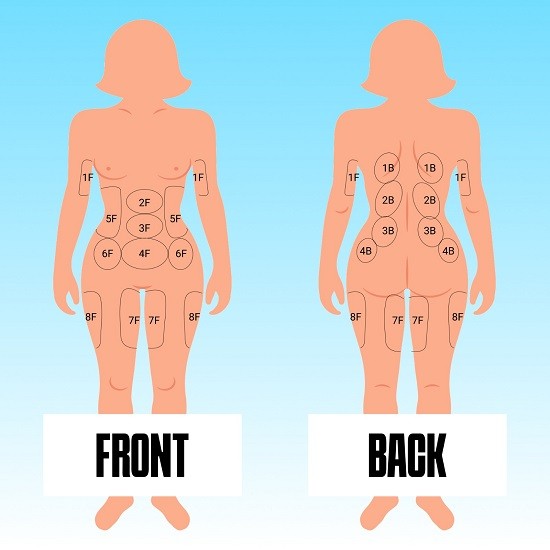
Body Contouring Services at Moein Surgical Arts in Los Angeles
Beyond standard liposuction, Dr. Moein offers specialized procedures for dramatic transformations:
Ab Etching: VASER or HD lipo carves visible six-pack definition by sculpting fat around your abdominal muscles. Best for lean patients with good muscle tone. Cost: $6,000-$12,000.
360-Degree Lipo: Complete torso makeover in one session—abdomen, flanks, back, and waist. Package pricing saves 20-30% versus treating areas separately. Cost: $8,000-$18,000.
Tummy Tuck + Lipo: Removes excess skin, tightens muscles, and eliminates stubborn fat. Perfect after pregnancy or weight loss when skin elasticity is compromised.
Brazilian Butt Lift + Lipo: Harvest fat from problem areas and transfer it to create rounder, lifted curves. Slim your waist while enhancing your buttocks—two goals, one recovery.
Combining procedures saves thousands on anesthesia and facility fees while cutting recovery time in half. Ask about package deals during your consultation.
And wondering how chain clinics like Sono Bello compare to private-practice liposuction with Dr. Moein? Please read our complete guide on Sono Bello cost in Los Angeles.
Why Choose Dr. Babak Moein for Your Liposuction in Los Angeles?
At Moein Surgical Arts, you’re not just another procedure. Dr. Moein is a board-certified cosmetic and general surgeon with over 20 years of specialized experience in body contouring and advanced liposuction techniques. His reputation throughout Los Angeles and Beverly Hills is built on:
- Board-certified by the American Board of Cosmetic Surgery – the gold standard
- 20+ years specializing in body contouring – VASER, HD lipo, and advanced techniques
- Thousands of successful transformations across Southern California
- Artistic precision – Results that look natural, never overdone
- Accredited surgical facility with the highest safety standards
- Transparent, all-inclusive pricing – No hidden fees or surprise bills
What Our Patients Say
Don’t just take our word for it. Hear from real patients who’ve transformed their bodies at Moein Surgical Arts. Read patient testimonials and see before/after results →
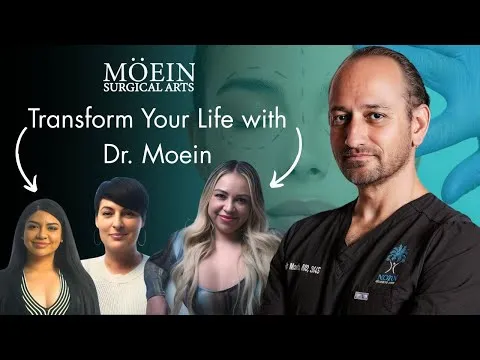
Schedule Your Liposuction Consultation in Los Angeles
Get transparent pricing, expert guidance, and a personalized treatment plan from Dr. Moein
In this article, we’ll walk you through the key differences between Sono Bello’s laser liposuction approach and VASER liposculpting, which is available from select, board-certified surgeons like Dr. Babak Moein in Los Angeles. We’ll cover what’s included in each, how the outcomes differ, and why choosing the right technology—and the right surgeon—can make or break your results.
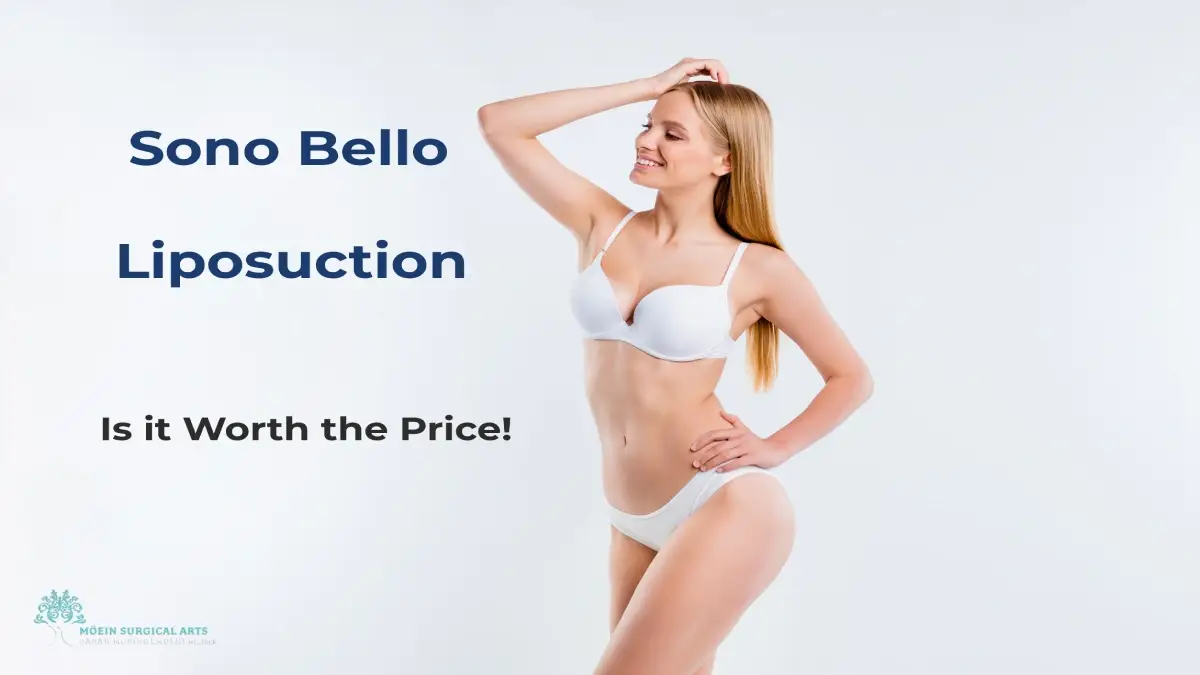
Table of Contents
What Is Sono Bello and How Does It Work?
Sono Bello is a chain of cosmetic clinics across the U.S. specializing in body contouring procedures, mainly laser-assisted liposuction. Their process uses lasers to melt fat before it is suctioned out of the body. This technique is minimally invasive and typically performed under local anesthesia.
While Sono Bello may offer convenience, short treatment windows, and broad advertising appeal, it is generally built around cookie-cutter protocols, with results varying based on which provider performs your procedure. Since many Sono Bello clinics operate with rotating or contracted surgeons, patients may not know who will perform their surgery until shortly before the procedure.
VASER Hi-Definition Liposculpting: A Different Level of Precision
VASER liposuction, or Vibration Amplification of Sound Energy at Resonance, is an advanced technique that utilizes ultrasound energy to emulsify fat prior to removal. This method allows for more precise sculpting while preserving surrounding tissues, resulting in smoother and more even results.
VASER is especially effective for 360-degree body contouring, where the entire midsection (abdomen, flanks, back, and more) is treated in a single, cohesive session. Unlike area-by-area laser lipo, this method improves overall body symmetry, avoids the “patchwork” look, and delivers a naturally toned appearance.
Can Sono Bello Laser Lipo Be Used for Fat Harvesting?

One of the most critical differences between Sono Bello and VASER liposuction is fat harvesting. Patients who are interested in fat transfer—such as a Brazilian Butt Lift, breast enhancement, or facial volume restoration—must consider this.
Sono Bello uses laser liposuction, which melts fat cells using thermal energy. This process damages the fat cells’ structure, rendering them unsuitable for fat transfer. The harvested fat is typically discarded.
On the other hand, VASER liposculpting preserves fat cell viability, making it ideal for patients who want to contour one area while enhancing another. In fact, at Moein Surgical Arts, many patients opt to remove fat from stubborn areas like the waist or thighs and reinject it into the buttocks, face, or breasts, with beautifully natural results.
If you’re considering fat transfer now or even as an option in the future, this is a key limitation of the Sono Bello technique.
Does Sono Bello Lipo Pricing Include Skin Tightening?

Another frequently asked question is whether Sono Bello includes skin tightening in their liposuction procedures. Based on reports and typical pricing breakdowns, the answer is often no. Laser lipo can promote a small amount of collagen remodeling, but it’s not a replacement for advanced tightening technologies.
In contrast, VASER liposuction creates heat at a deep tissue level, stimulating some degree of natural skin contraction. More importantly, VASER is often combined with Renuvion (J-Plasma), a cutting-edge skin tightening device that tightens skin from the inside out, without large incisions or extended downtime.
Patients in their 30s, 40s, or older who may have mild to moderate skin laxity see far superior results with VASER + Renuvion than with laser liposuction alone.
Area-by-Area Lipo vs. 360 VASER: Why It Matters
One of the biggest drawbacks of Sono Bello in Los Angeles is its area-based pricing and treatment structure. Patients are often quoted a per-area cost (e.g., lower abdomen, upper abdomen, flanks) without much focus on how the areas work together visually.
This “spot treatment” model can result in:
- Lumpy or uneven transitions between areas
- Poor proportionality
- Loose or sagging skin in untreated zones
With 360 VASER liposculpting, Dr. Moein addresses the full midsection in harmony, sculpting from all angles and contouring in a way that reflects your natural anatomy. This approach is ideal for patients seeking athletic definition or dramatic yet natural-looking improvement.
Price vs. Value: The Hidden Cost of Redo Surgery
When patients choose liposuction, they often look for the lowest price, but value is what matters most. While Sono Bello may advertise lower costs, the true expense shows up when the results don’t meet expectations.
Revision surgeries due to:
- Lumpy fat removal
- Asymmetry
- Sagging or uneven skin
- Lack of definition
…are not only more expensive—they’re emotionally draining. Fixing poor results often costs more than the original surgery, especially when more advanced techniques must be used to correct the damage.
With VASER liposculpting from a dedicated surgeon like Dr. Moein, you get an experienced hand from start to finish, significantly reducing your risk of disappointment or redo surgery altogether.
The Surgeon Matters: Predictability vs. a Roll of the Dice
One of the less obvious points of the Sono Bello approach is the uncertainty around your provider. In many locations, the surgeon performing your procedure might not be the one you consult with, or may not even be a full-time specialist at that clinic. This inconsistency can affect your outcome and the continuity of your care.
In contrast, Dr. Babak Moein is a dual board-certified surgeon who personally handles your consultation, procedure, and follow-up care. With over two decades of experience, he is known for combining medical expertise with artistic precision. His patients receive:
- A customized surgical plan
- Thoughtful pre- and post-operative care
- Realistic expectations and safe results
When your appearance and confidence are at stake, that kind of personalized experience makes all the difference.
How Does Sono Bello Pricing Compare to VASER Liposuction in Los Angeles?

When comparing Sono Bello to VASER liposuction, pricing can appear to be a major factor, but it’s important to understand what’s actually included. If pricing vs. value is your ONLY consideration, Sono Bello wins. If you want to factor value and long-term results, read on.
Sono Bello in Los Angeles generally advertises pricing from $1,200 to $1,500 per area, depending on your location and how many areas you’re treating. However, these costs are often quoted per body part (e.g., upper abdomen, lower abdomen, waistline, thighs – 6 areas ), and can add up quickly. Add-on costs for anesthesia, compression garments, and follow-up care may not always be included in the initial quote.
VASER liposuction, particularly when performed by an expert like Dr. Moein, is typically more comprehensive, especially as 360° body contouring. Pricing for VASER generally ranges from $9,500 to $14,500 per session, depending on the number of areas treated and the type of anesthesia. Also, if additional technologies like Renuvion skin tightening or fat transfer, not available with other offerings, are combined in the plan, your quote will be higher. At Moein Surgical Arts, your quote will INCLUDE anesthesia, the surgical suite, and follow-up visits.
Always explore “unbundled” costs. The difference in the cost of your surgical plans may be more on the surface but not by a lot once all costs are considered.
Here’s the key:
- You’re getting more advanced technology – more sculpting and some natural skin tightening.
- You’re treated as a unique case, not a chart of standard areas
- You avoid the common revision costs that can follow a more generic procedure
And perhaps most importantly, with Dr. Moein, you know who’s doing your surgery and the level of skill they bring to it.
So, while VASER may have a slightly higher entry price, the difference isn’t extreme, and for many patients, especially those having 360 liposuction, the extra investment pays off in better results, fewer surprises, and long-term satisfaction
Final Thoughts: Understanding the Real Difference Between Sono Bello and VASER in Los Angeles
Choosing between Sono Bello and VASER liposculpting isn’t just about price; it’s about priorities. Are you looking for quick, standardized fat removal or a customized, high-definition body sculpting experience? Do you want to hope for good results, or be confident in them from the start?
Sono Bello may be right for someone seeking minimal changes or a basic fat reduction approach. But VASER liposuction offers a more complete and artistically refined option if you aim for smooth, defined, and lasting results, especially with skin tightening or fat transfer in mind.
Next Steps: Choose the Surgeon and Technology That Elevate Your Results
If you’ve been exploring Sono Bello in Los Angeles, we encourage you to take the time to evaluate additional options. You may want to see what’s possible with the latest technology in the hands of a skilled artist. You might understand now why patients come from Los Angeles and beyond to see Dr. Moein.
Take the risk-free next steps:
- Book a private consultation with Dr. Babak Moein
- Get a personalized 360-degree body evaluation
- Learn whether VASER liposculpting is the right technique for your goals
- Discover the confidence and peace of mind that comes with doing it right the first time
Call (310)455- 8020 or click here to schedule your appointment at Moein Surgical Arts in Los Angeles.
Because your body deserves more than average.
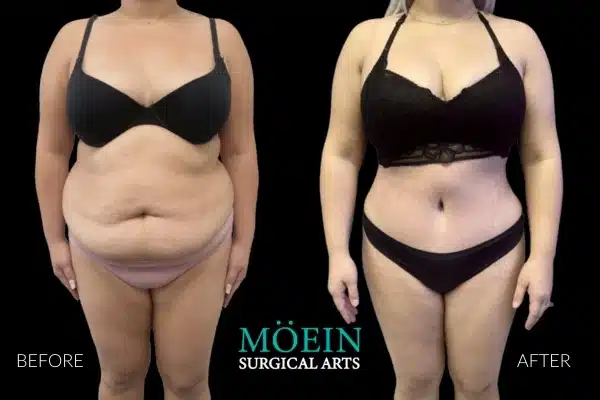
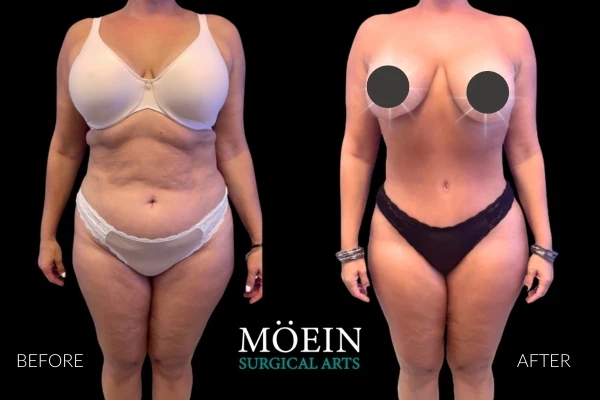
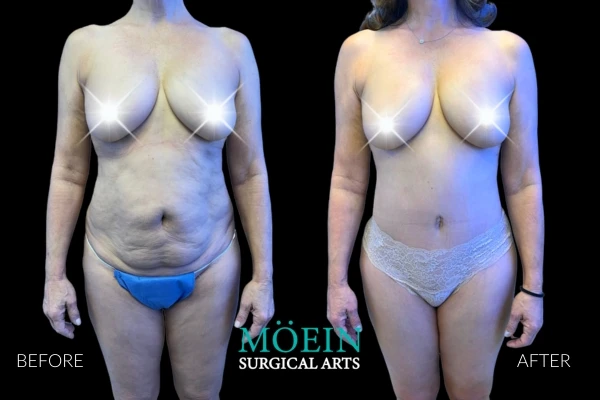
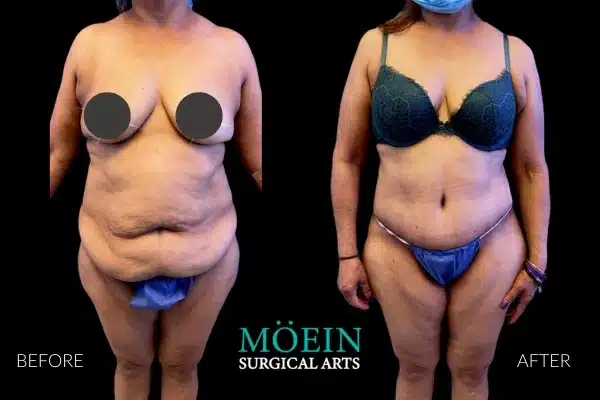
Flank liposuction, a most effective means of shaping the waistline area and getting rid of those ‘love handles ’, has remained one of the leading cosmetic procedures available in Los Angeles. The ‘Before and After’ gallery on this page features actual patients who achieved a slimmer, more contoured figure with cosmetic surgeon Dr. Moein and VASER-assisted liposuction.
These results emphasize the importance of fat extraction in the flanks in shaping the waistline and enhancing one’s proportion and overall figure. Every case illustrates the accuracy, safety, and artistry with which Moein Surgical Arts performs the procedure of flank liposuction.
For many individuals, the flanks are among the most resistant areas of fat, often being unaffected despite exercise, diet, and weight loss. A liposuction procedure on the sides provides a very effective way to selectively reduce fat by creating a few entry points, so the waistline can look slimmer, smoother, and narrower. VASER-assisted liposuction is even more precise, enhancing sculpting and reducing recovery time.
The ‘Before and After cosmetic surgery‘ pictures on this page feature a series of patients of different ages and physiques, which better illustrate how individualized flank liposuction can be. A person may seek only a slight change in the definition of the waistline, whereas others may seek a much more dramatic alteration; these cases clearly convey just what can be accomplished with the highest order of results. These outcomes reflect Dr. Moein’s expertise and his commitment to delivering natural, balanced, long-lasting improvement.
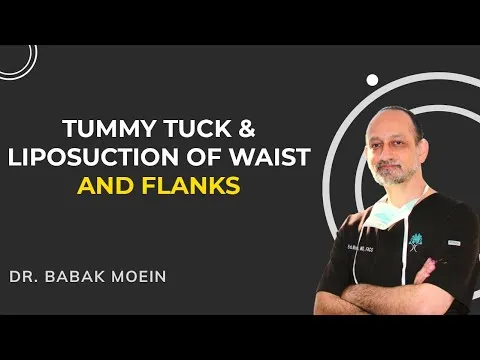
Candidates for Flank Liposuction
Patients suitable for both upper and lower flank liposuction are those who lead healthy lives but find it difficult to eliminate fat in the upper pelvis, such as the “love handles” or “muffin tops” when viewed from the back. These are fat deposits that are not affected by healthy eating or exercise, which is why liposuction is needed.
Patients looking to refine their figure with a more defined waist or a snatched, hourglass figure can have both procedures combined to help the flanks through fat reduction via liposuction. Patients looking for a dramatic change in the waist area can learn more in our other guides, such as how to get a snatched waist in Los Angeles.
In addition, the results of liposuction can serve as motivation to maintain a healthy diet and exercise routine. Knowing that the investment they made in their bodies can be further enhanced by maintaining a healthy lifestyle can be a powerful incentive for candidates. Overall, ideal candidates are those with realistic expectations, stable weight, and a desire to refine the waistline through precise surgical contouring.
How much fat can be removed?
The quantity of fat that can potentially be aspirated in flank liposuction can vary from patient to patient, depending on the overall size and physical well-being of the individual. In most cases, there needs to be an appropriate limitation outlined in terms of safety, up to 5 liters of aspiration. However, the quantity can vary based on individual considerations in the course of surgery.
In the process, Dr. Moein considers numerous factors, such as BMI, skin quality, and fat distribution, to determine how much fat can be safely and effectively removed. It is essential to consider that removing excessive fat increases the risk of complications, such as fluid shifts or irregularities in fat distribution.
When patients compare treatment alternatives or plan their finances, our comprehensive resource, “Liposuction Cost in Los Angeles,” helps you understand the factors that contribute to cost, so you can understand what impacts your financial outlay.
Liposuction Surgery Explained
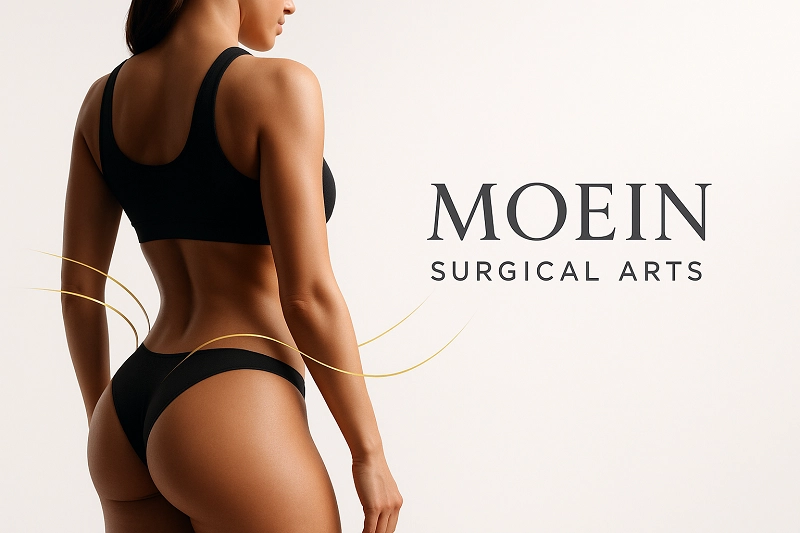
Liposuction is a body-contouring procedure designed to remove stubborn fat that does not respond to diet or exercise. During the surgery, a thin tube called a cannula is inserted through small incisions to precisely suction out fat and sculpt the treated area. Modern techniques, such as VASER ultrasound-assisted liposuction, allow for greater precision, smoother results, and reduced trauma compared to older methods.
Liposuction is not intended for weight loss. Instead, it is most effective for patients who are near their ideal body weight but have localized fat deposits in areas such as the flanks, abdomen, thighs, arms, or neck. Ideal candidates maintain good overall health, have realistic expectations, and are seeking improved contour rather than large-volume fat removal.
When performed safely, liposuction offers long-lasting improvements in body shape, enhanced proportions, and increased confidence. Results can be maintained long-term with a stable weight, healthy nutrition, and regular physical activity.
Flank Liposuction Procedure: Step-by-Step Guide
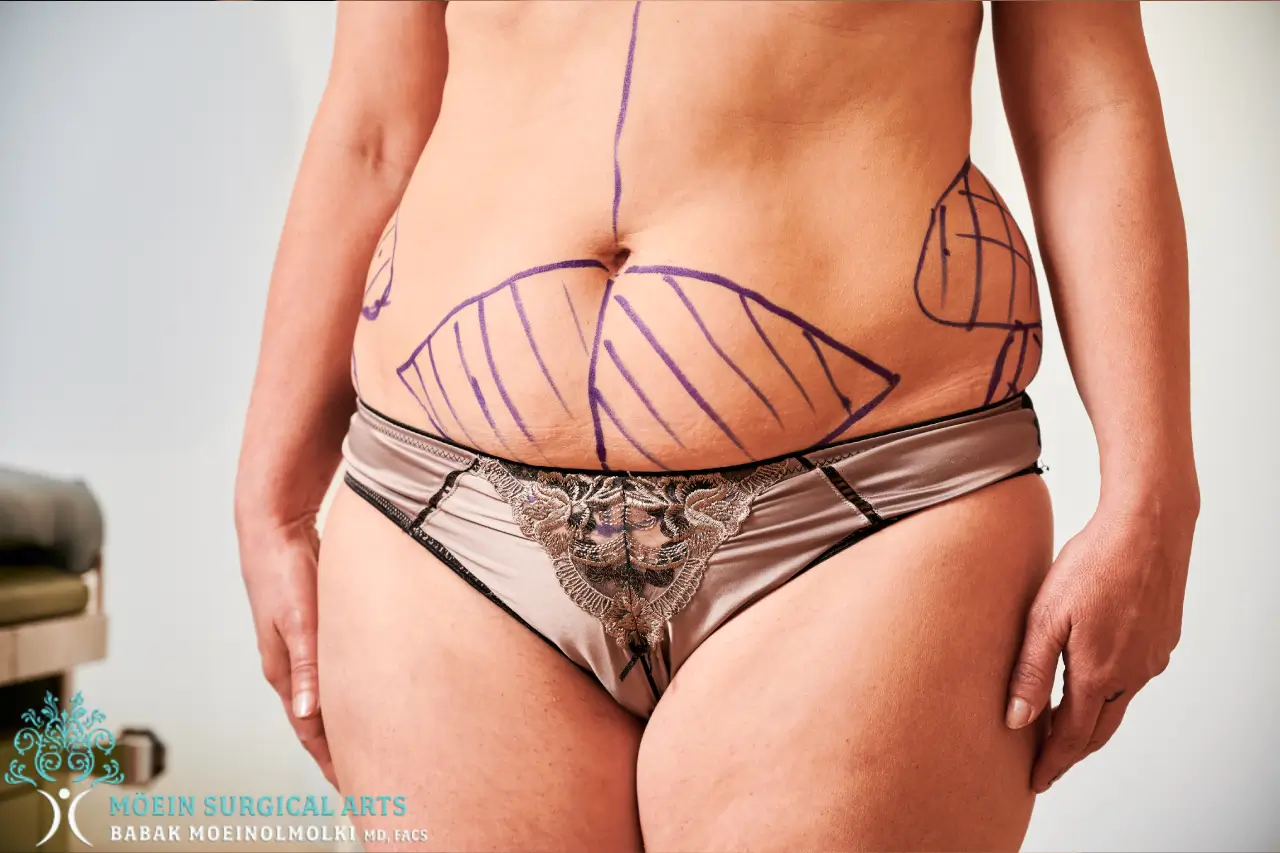
Flank liposuction can help eliminate resistant fat in the waist area and give the abdomen a smoother, more contoured shape. The process involves conducting an examination and procedure plan, administering anesthesia, and marking critical areas that require further sculpting. After applying the fluid, VASER or regular liposuction can help break up fat, allowing sculpting in the flanks.
The small incisions are closed with tiny sutures, and the patient can thereafter wear a compression garment to help support healing and further define the final result. Most patients can return to all activities in several days, with progressive definition to follow.
Key Steps in the Procedure
- Pre-operative consultation and custom surgical planning
- Anesthesia for comfort and safety
- Strategic marking of the flanks
- Tumescent infiltration to prepare the area
- Precise fat removal using VASER or traditional liposuction
- Symmetry checks throughout the procedure
- Compression garment applied after surgery
With the surgical process explained, we can now review several real flank liposuction case examples to show how different techniques and body types respond to treatment.
Lipo 360 – Abdomen, Flanks, and Back (49-Year-Old Woman)

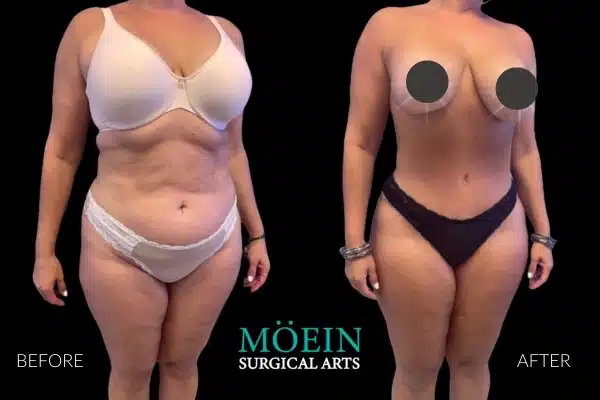
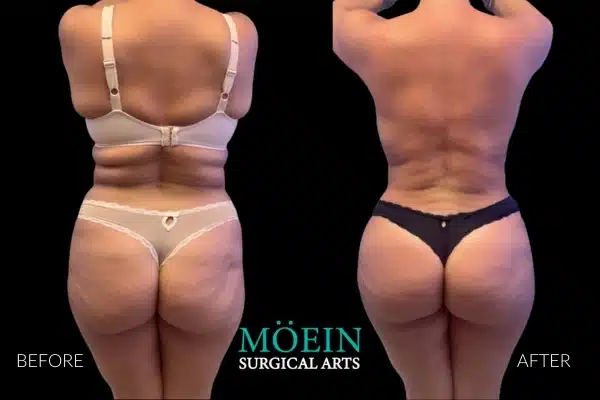
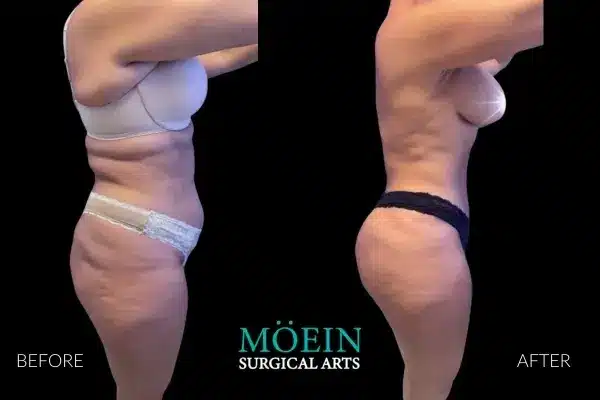
The 49-year-old female patient underwent an Lipo 360 procedure to target the abdomen, flanks, and both upper and lower back to flatten the midsection and further smooth the figure. The patient had hard fat deposits in both the waist and the back.
Using VASER-assisted liposuction, the dense fat in the flanks and back was treated. Standard suction-assisted liposuction was performed in the central and lower abdominal areas to reduce fat. In aggregate, approximately 2.2 to 2.5 liters of fat were aspirated across all treated areas. There was a proportionate distribution of the fat to maintain symmetry.
Also, through the process of defining her lower back and reducing her waistline, her waist-to-hip ratio was enhanced. In fact, her stomach appears flatter and toned in every photo. Evidently, her midsection has toned up, and her back looks smooth with a narrower waist.
Liposuction of Flanks and Back – Significant Waistline Reduction
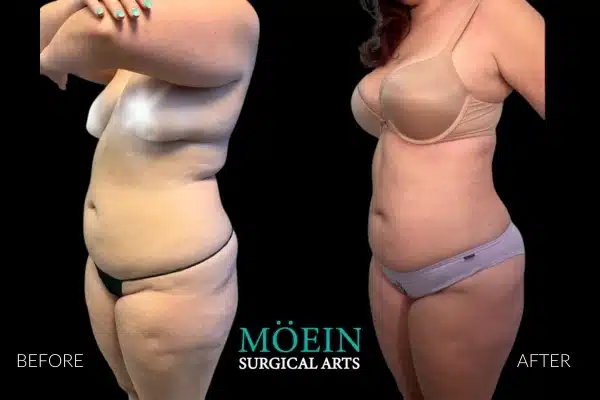
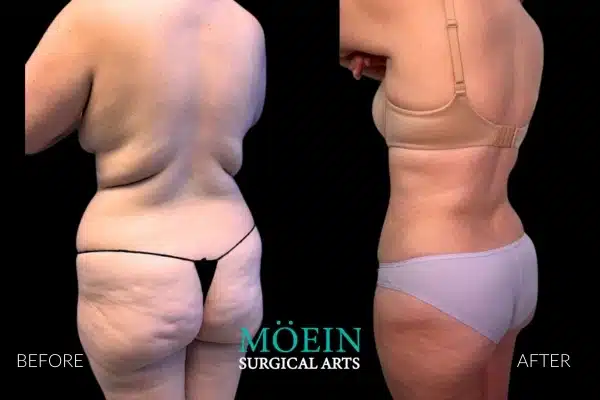
The patient underwent focused liposuction of the flanks and upper and lower back to target the area of fullness around the waistline and bra-line folds. These areas can be very difficult to lose through exercise or diet, and can contribute to an uneven waistline.
Using VASER-assisted liposuction, the fat in the back and sides was emulsified to make it easier to remove while simultaneously facilitating skin retraction. Conventional suction-assisted liposuction was utilized to define the waistline and the junction between the lower back and hip.
In all, about 1.8 to 2.2 liters of fat was estimated to have been shed from the flanks and back. It all translates to a narrower waist, a smoother back, and a more defined midsection, all evident in the after photos.
These advances underscore how focused flank or back liposuction can dramatically alter the waistline without directly treating the abdomen or thighs.
Male Liposuction of Chest, Abdomen, Flanks, and Back (Including Gynecomastia Correction)
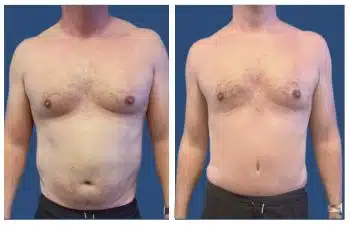
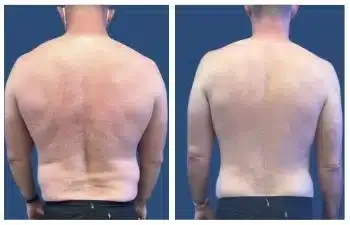
This male patient underwent comprehensive body contouring, including liposuction of the chest, abdomen, flanks, and back, with a focus on improving upper-body definition. A combination of VASER ultrasound-assisted liposuction and traditional liposuction was used to break down dense fat and sculpt the torso more effectively.
A key component of this case was male chest contouring for gynecomastia-like fullness. Excess fatty tissue was removed from the chest to create a flatter, more masculine contour and better definition along the pectoral borders. This approach helps reduce the appearance of chest roundness and enhances overall upper-body proportionality.
Liposuction of the abdomen and flanks helped flatten the midsection and refine the waistline, while fat removal from the upper and lower back smoothed bulges and improved the patient’s profile. Across all treated regions, fat was removed strategically to maintain symmetry and natural muscular highlights.
The after photos show a clearer chest definition, a slimmer waist, and a noticeably more athletic shape from multiple angles — demonstrating how multi-area liposuction can dramatically enhance male torso aesthetics.
Flank and Waist Vaser Liposuction – Female Waistline Contouring
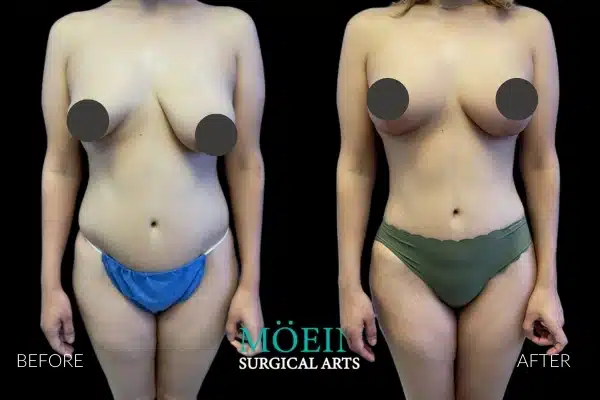
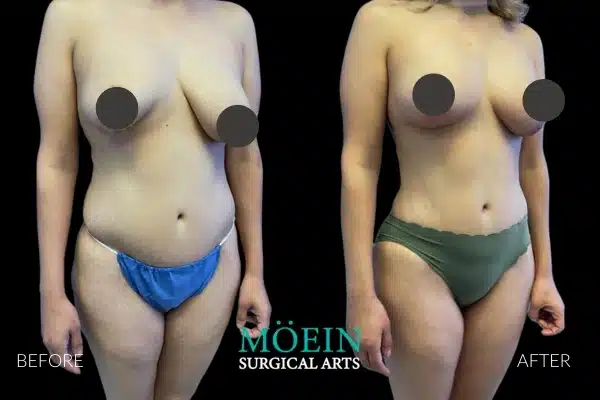

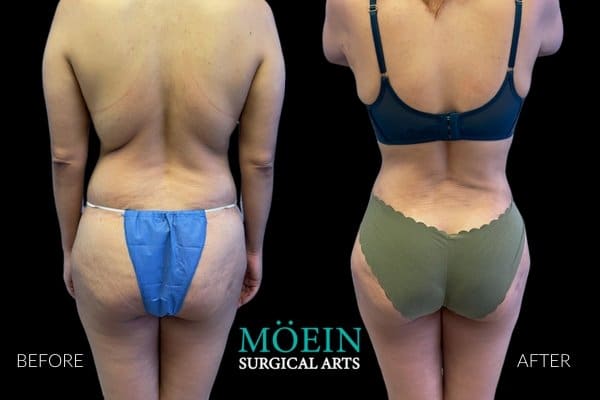
This female patient underwent targeted liposuction of the flanks, waistline, and lower back to address stubborn fat that was blunting her natural curves. These areas are common problem zones that resist diet and exercise, often creating a boxy midsection.
Using VASER-assisted liposuction, Dr. Moein loosened dense fat along the waist and lower back, allowing for smooth extraction and enhanced definition. Traditional suction liposuction was then used to refine the waistline and create a more tapered, feminine silhouette.
Approximately 1.4 to 1.8 liters of fat were removed across the flanks and back. Her after photos show a noticeably slimmer waist, a smoother lower back profile, and improved overall body balance from every angle.
High-Definition Lipo 360 – Abdomen, Flanks & Back Contouring

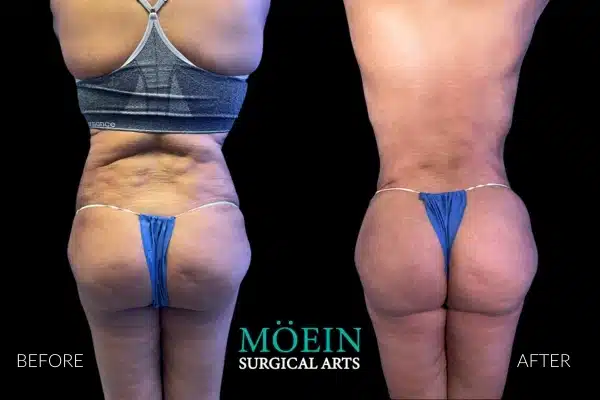
This patient underwent a high-definition Lipo 360 procedure targeting the abdomen, flanks, waistline, and full back to dramatically improve midsection shape. She presented with central abdominal fullness, resistant flank fat, and lower back rolls that created a wider, less-defined torso.
Using VASER-assisted liposuction, qualified Cosmetic Surgeon Dr. Moein emulsified dense fat throughout the abdomen and back, allowing for controlled sculpting and enhanced definition. Additional suction liposuction refined the waistline and highlighted natural abdominal lines without over-carving or creating an artificial look.
A total of approximately 2.5 to 3 liters of fat was removed across the abdomen, flanks, and back. The level of waist reduction and abdominal refinement seen in her results reflects the advantages of individualized, high-definition contouring. Compared with mass-produced approaches such as those used by Sono Bello, this method focuses on artistry, symmetry, and shaping, not just volume removal.
This transformation demonstrates how high-definition Lipo 360 can reshape the abdomen and back simultaneously, delivering a smoother, more youthful silhouette from every angle.
Recovery from Liposuction
Recovery from liposuction surgery is an essential part of the overall treatment process. The duration of recovery can vary depending on the extent of the procedure and the individual’s healing response. However, most patients can expect a recovery period of two to four weeks. During this time, it is crucial to follow post-operative instructions diligently to ensure optimal healing and minimize complications.
Following liposuction surgery, patients are often recommended to engage in light activities and gradually increase their level of physical activity as tolerated. Strenuous exercises should be avoided for the first few weeks to prevent any undue stress on the surgical site. Gentle walking, on the other hand, is highly encouraged as it promotes blood circulation and reduces the risk of complications such as blood clots.
Another crucial aspect of the recovery process is the use of a compression garment. This garment helps reduce swelling, assist in contouring, and provides support to the treated areas. Patients are advised to wear this garment continuously for the first few weeks after surgery and then as directed by their surgeon.
Walking plays a vital role in minimizing complications after liposuction surgery. It aids in preventing blood clots, stimulating circulation, reducing swelling, and avoiding stiffness. By encouraging patients to walk regularly, surgeons ensure a smoother recovery and help patients regain their mobility more quickly.
In conclusion, the recovery period following liposuction surgery typically lasts two to four weeks. During this time, patients are advised to engage in light activities, continuously wear a compression garment, and walk regularly to minimize complications. Following these guidelines will help ensure a successful recovery from liposuction.
Conclusion: Lipo of Flanks Before and After
The “Conclusion: Lipo of Flanks Before and After” section is of utmost importance as it serves as a crucial summary of the liposuction results obtained on the patient’s flanks. This section allows the reader to gather a comprehensive understanding of the overall outcomes and transformation achieved through the procedure.
By providing a concise summary of the before and after results, the conclusion highlights the significant changes that occurred in the patient’s flanks. It allows the reader to gauge the effectiveness of the liposuction procedure in addressing the specific concerns related to the flanks. This section plays a pivotal role in depicting the success of the procedure in helping the patient achieve their desired outcome.
Furthermore, the conclusion also serves as a testament to the expertise and skill of the medical professional performing the liposuction. It showcases their ability to sculpt and contour the flanks, resulting in a positive aesthetic transformation. This summary serves as an informative piece for future patients who may be considering the same procedure, allowing them to visualize the potential outcomes and decide if it aligns with their goals.
In conclusion, the “Conclusion: Lipo of Flanks Before and After” section is essential in highlighting the overall outcomes and transformation achieved through the liposuction procedure on the flanks. It provides a concise summary of the before and after results, allowing the reader to gauge the effectiveness of the procedure and appreciate the skill of the medical professional.
]]>In the realm of cosmetic surgery, the pursuit of aesthetic perfection and physical rejuvenation is a journey that combines art with advanced medical technology. One of the most transformative procedures in this field is High-Definition Liposuction 360 combined with Abdominal Skin Resection. This innovative technique is not just about removing unwanted fat; it’s about sculpting the body in a way that highlights natural contours and muscle definition, offering results that go beyond traditional liposuction.
The Evolution of Liposuction: Embracing High-Definition Techniques
Liposuction has evolved significantly since its inception. Traditional methods focused primarily on the removal of excess fat. However, with the advent of High-Definition (HD) techniques, such as VASER liposuction, the goal has shifted towards creating a more sculpted and athletic appearance. This advanced technology uses ultrasonic waves to break down fat cells while preserving vital tissues, leading to more precise contouring and less downtime.
Case Study: A Journey to Youthful Contours
Recently, I had the privilege of performing HD Liposuction 360 with a modified abdominal excision on a 51-year-old patient. Her goal was to not just lose fat but to gain a more youthful, athletic look. This case exemplifies the transformative power of combining HD liposuction with skin resection techniques.
Understanding HD Liposuction 360
HD Liposuction 360 is a comprehensive approach that targets the entire circumference of the midsection. This 360-degree technique ensures a harmonious, balanced look, as it addresses not just the abdomen but also the flanks and back. The result is a more natural, aesthetically pleasing body contour.

The Role of Abdominal Skin Resection
In cases where there is excess skin, as often seen in patients who have experienced significant weight loss or changes in body shape, a simple liposuction may not suffice. This is where abdominal skin resection plays a crucial role. In my recent case, the patient had undergone a previous tummy tuck, necessitating a modified approach to address the extra skin and tighten her core.
The Art of Muscle Highlighting
One of the most striking aspects of HD Liposuction 360 is its ability to accentuate muscle definition. By strategically removing fat around muscle groups, it’s possible to highlight areas like the abdominal muscles, creating a more toned and athletic appearance. In this particular case, the patient’s desire for muscle highlights was a key focus of the procedure.
Post-Operative Transformation and Recovery
Immediately following the surgery, the results are visibly promising, despite the presence of post-operative swelling. This swelling is a normal part of the healing process and gradually subsides, revealing the finely-tuned contours underneath. As the patient recovers, the muscle structures become more defined, achieving the desired aesthetic outcome.
The Importance of Personalized Care in Cosmetic Surgery
Every patient’s body and aesthetic goals are unique. Therefore, a personalized approach is paramount in cosmetic surgery. Understanding the patient’s specific desires and combining various techniques to address their individual needs is the cornerstone of successful outcomes.
Advancements in Cosmetic Surgery Techniques
The field of cosmetic surgery is continually evolving, with new techniques and technologies emerging regularly. Staying abreast of these advancements is crucial for any practitioner aiming to provide the best possible care and results for their patients.
Choosing the Right Surgeon for Your Cosmetic Journey
For those considering cosmetic surgery, selecting a surgeon with extensive experience and a track record of successful outcomes is vital. A surgeon’s expertise in advanced techniques like HD Liposuction 360 and abdominal skin resection can significantly impact the quality of the results.
Conclusion: A Fusion of Art and Science
HD Liposuction 360 with Abdominal Skin Resection is more than just a cosmetic procedure; it’s a fusion of art and medical science. It represents a commitment to helping patients achieve their aesthetic goals while ensuring their safety and well-being. As we continue to push the boundaries of what’s possible in cosmetic surgery, we open doors to new possibilities for patient satisfaction and transformative results.
]]>When it comes to body contouring, both Liposuction vs Tummy Tuck are popular options for individuals looking to achieve a more toned and defined appearance. Liposuction targets specific areas of stubborn fat, such as the abdomen, thighs, or arms, by removing excess fat deposits through a suctioning process. On the other hand, a tummy tuck, also known as abdominoplasty, focuses on removing excess skin and tightening the abdominal muscles to create a flatter and smoother stomach area.
Ideal candidates for liposuction are generally individuals who are close to their target weight but are struggling with localized pockets of fat that are resistant to diet and exercise. Tummy tuck candidates, however, are usually those who have lost a considerable amount of weight or have excess skin and muscle laxity in the abdominal area, often due to pregnancy or significant weight loss.
Men, in particular, may feel dissatisfied with their bodies due to societal pressures and influences from social media, which highlight the ideal masculine body shape. This can lead to a desire for body contouring procedures to achieve the desired look. It is crucial for individuals to consider their individual needs and goals when choosing between liposuction and tummy tuck to ensure that the right procedure is selected for optimal results.

What Is a Tummy Tuck?
A tummy tuck, also known as abdominoplasty, is a cosmetic surgical procedure used to improve the appearance of the abdomen by removing excess skin and fat and tightening the abdominal muscles.
There are different types of tummy tuck procedures, including the complete tummy tuck, mini tummy tuck, and circumferential abdominoplasty. A complete tummy tuck involves an incision from hip to hip, the removal of excess skin and fat, and the tightening of abdominal muscles. A mini tummy tuck is a less extensive procedure, typically focusing on the area below the belly button. Circumferential abdominoplasty is a more extensive procedure that also includes the removal of excess skin and fat from the back.
The process and recovery expectations for each type of tummy tuck vary, with complete tummy tucks having a longer recovery time than mini tummy tucks. Potential benefits of the procedure include a more toned and slim abdomen, while potential risks include scarring, infection, and complications from anesthesia.
Before considering a tummy tuck, it is important to consult with a board-certified Cosmetic Surgeon to determine the most appropriate procedure based on individual needs and goals.
What Is Liposuction?
Liposuction is a cosmetic surgical procedure that aims to remove excess fat from targeted areas of the body. The procedure involves making small incisions in the skin and using a thin tube, called a cannula, to suction out the fat. Liposuction is typically used to remove fat from areas such as the abdomen, thighs, hips, buttocks, and arms. It is not intended for weight loss, but rather for sculpting and contouring the body.
On the other hand, a tummy tuck, also known as abdominoplasty, is a more extensive surgical procedure that not only removes excess fat but also tightens the abdominal muscles and removes excess skin. The procedure involves making a larger incision along the lower abdomen, repositioning the belly button if necessary, and removing excess skin and fat.
Both liposuction and a tummy tuck have limitations when it comes to major obesity. They are not substitutes for a healthy weight loss program and are best suited for individuals who are close to their ideal body weight. The recovery time for liposuction is typically shorter than that of a tummy tuck, with most patients able to resume normal activities within a few days to a week. A tummy tuck, on the other hand, may require several weeks of recovery and downtime.
Liposuction versus Tummy Tuck: The Comparison
Liposuction and tummy tuck are two popular cosmetic procedures that are often considered for body contouring and fat reduction.
Liposuction is a minimally invasive procedure that targets stubborn pockets of fat and removes them through a suction device. It is ideal for individuals who are close to their ideal weight but have localized areas of fat that won’t respond to diet and exercise. The results of liposuction are generally subtle, with a more sculpted appearance in the treated areas. The recovery time for liposuction is relatively short, with minimal pain and scarring.
On the other hand, a tummy tuck, also known as abdominoplasty, is a more invasive procedure that not only removes excess fat but also tightens the abdominal muscles and removes sagging skin. The results of a tummy tuck are more dramatic, with a flatter and firmer abdomen. However, the recovery time for a tummy tuck is longer, with more discomfort and noticeable scarring.
In terms of procedure invasiveness, recovery times, pain, and scarring, liposuction is generally less invasive with a quicker recovery, less pain, and minimal scarring compared to a tummy tuck. However, tummy tucks typically produce more dramatic results and are more suitable for individuals with significant excess skin and muscle laxity. In terms of cost, tummy tucks are generally more expensive than liposuction due to the complexity of the procedure.

Who Is a Good Candidate for Liposuction vs. Tummy Tuck?
Good candidates for liposuction are individuals who have stubborn pockets of fat that do not respond to diet and exercise. They should be at or near their ideal weight, have good skin elasticity, and be in overall good health. Candidates for a tummy tuck, or abdominoplasty, are typically those who have excess skin, weakened abdominal muscles, and localized fat in the abdominal area. They should also be at a stable weight and in good general health.
It is important for candidates for both procedures to have realistic expectations about the outcomes and to be committed to maintaining a healthy lifestyle after the surgery. Weight loss should ideally be achieved before undergoing these procedures, as they are not a weight loss solution. It is also important to quit smoking, as it can increase the risk of complications and slow down the healing process.
Complicating factors for both procedures include obesity, diabetes, heart disease, and other serious medical conditions. It is important for candidates to thoroughly discuss their health history with a qualified Cosmetic Surgeon to ensure a safe and successful outcome.
Tummy Tuck and Liposuction: Recovery
The recovery process for a tummy tuck and liposuction differs in several ways.
The recovery from a tummy tuck is more extensive than liposuction, as it involves the removal of excess skin and tightening of the abdominal muscles. The expected duration of recovery for a tummy tuck is around 2-4 weeks, whereas for liposuction it is around 1-2 weeks.
After a tummy tuck, patients are usually advised to wear compression garments to minimize swelling and support the abdominal area. In contrast, patients who undergo liposuction may also be required to wear compression garments, but for a shorter period.
Managing discomfort is an important aspect of both recoveries. Pain medication may be prescribed to alleviate any discomfort, but it is generally more intense for a tummy tuck due to the muscle repair involved.
Recommended activities during recovery also vary. Patients may be instructed to avoid strenuous activities for a longer period after a tummy tuck compared to liposuction, which may have a shorter period of restricted activities.
In summary, the recovery process for a tummy tuck is more extensive than liposuction, involving longer recovery duration, the use of compression garments for a longer period, more intense discomfort management, and a longer period of restricted activities.
What Results Can I Expect?
When starting any new endeavor or embarking on a new journey, it’s natural to wonder what kind of results you can expect. Whether it’s a fitness program, a new job, or a new hobby, understanding what you can hope to achieve is an important part of setting realistic goals and expectations. In the following headings, we will explore the potential outcomes and results that you can expect when starting something new, providing insight and realistic information to help you on your path to success.
Tummy Tuck Results
If you are considering a tummy tuck procedure, the potential results include a smoother and firmer abdominal profile, as excess skin and fat are removed. While there will be a visible horizontal scar initially, it typically fades over time. Patients also often experience improved confidence in clothing and swimwear.
It’s important to note that the results of a tummy tuck differ from those of liposuction. A tummy tuck focuses on the permanent removal of excess skin and fat tissue, resulting in a tighter and flatter abdomen, while liposuction targets specific areas of fat but does not address loose skin.
Weight gain and future pregnancies can impact the long-term results of both procedures. Significant weight gain after a tummy tuck can affect the firmness of the abdomen, while subsequent pregnancies can stretch the skin and muscles, potentially reversing the results of the surgery. It’s recommended for patients to be at a stable weight and have completed their family planning before undergoing a tummy tuck to maximize long-term results.
Liposuction Results
Liposuction is a long-lasting solution for body contouring, targeting stubborn fat deposits in areas such as the abdomen, thighs, and arms. The procedure involves removing excess fat cells through a suction technique, resulting in a more sculpted and defined appearance.
In comparison, a tummy tuck focuses on removing excess skin and tightening the abdominal muscles, resulting in a flatter and firmer abdomen.
The recovery process for liposuction typically involves mild discomfort, bruising, and swelling, with most patients able to return to work within a few days and resume exercise within a few weeks.
When considering which procedure is suitable, it’s essential to evaluate the amount of excess fat and skin in the targeted area. Liposuction is ideal for those with localized fat deposits, while a tummy tuck may be more suitable for those with excess skin and muscle laxity.
Potential side effects of liposuction include temporary numbness, uneven contours, or fluid accumulation, but these are usually rare and improve with time. The recovery period varies for each individual, but most individuals can expect to see final results within six months to a year. Overall, liposuction offers long-lasting body contouring benefits with minimal downtime.
Tummy Tuck, Liposuction, or Both?
Tummy tuck, also known as abdominoplasty, is a surgical procedure that removes excess skin and fat from the abdominal area and tightens the abdominal muscles. This is a good option for individuals who have sagging skin or weakened muscles due to weight loss, pregnancy, or aging. Candidates for a tummy tuck should be in good overall health, have realistic expectations, and be at a stable weight.
Liposuction, on the other hand, is a minimally invasive procedure that targets specific areas of stubborn fat deposits in the body. This is a good option for individuals who have localized areas of fat that are resistant to diet and exercise. Candidates for liposuction should be within their ideal weight range, have good skin elasticity, and be in good overall health.
A combination of both procedures can be suitable for individuals who have both excess skin and stubborn fat deposits in the abdominal area. This approach can provide comprehensive improvement in the overall appearance of the midsection. Candidates for a combination procedure should meet the qualifications for both tummy tuck and liposuction and should consult with a qualified Cosmetic Surgeon to determine the best approach for their individual needs.
Before scheduling any surgical procedure, individuals should carefully consider the potential risks, recovery time, and long-term commitment to maintaining a healthy lifestyle. It is important to consult with a board-certified Cosmetic Surgeon to discuss the best options and expected outcomes.
Conclusion: Liposuction vs Tummy Tuck: Best for Body Contouring
In conclusion, the key differences between liposuction vs tummy tuck procedures lie in the areas of the body they target and the outcomes they achieve. Liposuction primarily targets and removes excess fat from specific areas of the body, while a tummy tuck focuses on removing excess skin and tightening the abdominal muscles.
The combination of liposuction and tummy tuck can be beneficial for individuals seeking comprehensive body contouring results. This combination can address both excess fat and skin, resulting in a more sculpted and toned appearance.
Before and after pictures can effectively illustrate the results of each procedure. Liposuction may show a reduction in localized fat deposits, while a tummy tuck can demonstrate a smoother and more contoured abdomen.
Ultimately, the choice between liposuction and tummy tuck depends on the specific concerns and goals of the individual. Consulting with a qualified Cosmetic Surgeon is crucial in determining the most suitable approach for achieving desired body contouring results.
]]>Welcome to J Plasma and Liposuction, an innovative approach blending fat removal and skin tightening into one minimally invasive procedure.
Picture this: stubborn fat deposits disappearing while your skin tightens in response, all within minimal downtime! Sounds like magic? There is no magic here – let’s explore the science behind J plasma liposuction, its unique helium gas blend, and why it outperforms traditional methods.
Hang tight as we delve into J plasma and liposuction, its unique blend with helium gas for maximum effect, and why people rave about its benefits over traditional liposuction methods – everything you need is right here!
Table Of Contents:
- Understanding J Plasma and Liposuction
- Procedure Details for J Plasma and Liposuction
- The Role of Helium Gas in Skin Tightening
- Anesthesia Options for J Plasma and Liposuction
- Post-Treatment Care & Recovery Process
- Results and Benefits of Undergoing J Plasma and Liposuction
- Combining Procedures with J Plasma and Liposuction
- Choosing a Surgeon for Your J Plasma Liposuction Procedure
- Cost Considerations for J Plasma Liposuction
- FAQs About J Plasma Liposuction
- Conclusion
- What’s Next?
Understanding J Plasma and Liposuction
J Plasma, also known as Renuvion skin tightening, is a revolutionary treatment plan that blends the fat removal of traditional liposuction with the unique properties of cold plasma energy. But how does this innovative procedure work, and what makes it stand out?
The Science Behind J Plasma Technology
J Plasma technology harnesses the power of helium gas – an inert gas often used in medical procedures. When ionized, helium becomes cold plasma. This high-energy state allows for precise control during minimally invasive cosmetic surgery.
When added to liposuction, these qualities create something truly special: Renuvion J-Plasma lipo. This process uses radio frequency to heat and tighten sagging skin while removing stubborn fat deposits from targeted areas such as the abdomen, arms, or thighs.
Cold helium plasma’s unique ability to cool instantly protects surrounding tissues from excessive heat damage. That means less scar tissue formation than traditional methods and minimal post-surgery downtime.
In terms of effectiveness, there’s no comparison – a 69% success rate says it all. The immediate results are firmer skin and enhanced body contouring due to reduced loose skin laxity; however, collagen production continues over time, making your improvements even more noticeable after your initial recovery period ends.
Beyond Just Fat Removal
Adding J-plasma into the mix takes this beyond simple weight loss through fat transfer – now we’re talking genuine rejuvenation.
The small cannula used for liposuction can deliver negative pressure (to remove excess fatty tissue) and ionized helium gas (for skin tightening). The dual action of fat removal and simultaneous plasma skin tightening provides more comprehensive results. It’s like getting a tummy tuck without the need for major surgery.
With J Plasma and liposuction, especially VASER lipo, we can treat loose skin requiring surgical intervention with far less trauma and downtime.
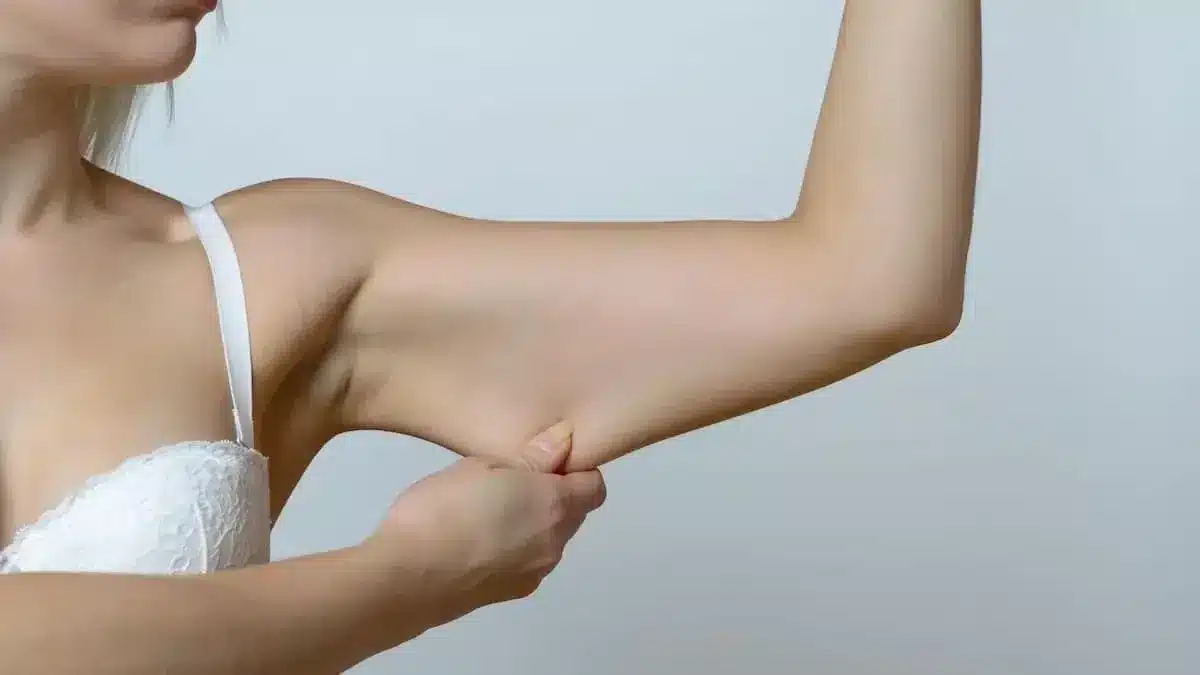
Procedure Details for J Plasma and Liposuction
The journey to a firmer, rejuvenated body with the help of J-Plasma liposuction starts long before you set foot in the operating room. It begins with preparing yourself physically and mentally.
To get ready, ensure your body is at its ideal weight because significant weight gain or loss after the procedure could affect results. Remember that this isn’t a weight loss method but a technique for targeted fat removal and skin tightening.
The Role of Helium Gas in Skin Tightening
In traditional liposuction procedures, small incisions remove excess fat deposits from targeted areas like the abdomen and arms. But when it comes to J-Plasma lipo, we’re adding an exciting twist – cold helium plasma.
This inert gas becomes ionized under radio frequency energy, creating unique properties that let us tighten loose skin while removing stubborn fat cells.
J-Plasma’s use of helium offers multiple benefits due to its natural characteristics as an inert gas combined with radiofrequency (RF) energy. The RF energizes the helium into a plasma state, delivering controlled heating effects without causing damage to surrounding tissues.
Anesthesia Options for J Plasma and Liposuction
Next up on our step-by-step guide: anesthesia options. An experienced Cosmetic Surgeon will give you options based on your comfort level and specific treatment plan – these typically include local or general anesthesia depending upon treated area size and patient preference. Mayo Clinic provides further insights here.
Post-Treatment Care & Recovery Process
- A compression garment is usually worn for several weeks post-procedure to help reduce swelling and assist in skin tightening.
- After the procedure, patients typically need about a week off from work or daily activities. But remember, everyone’s recovery time varies based on individual health status and body response. Statistically speaking, downtime for J-Plasma lipo averages around a week.
Results and Benefits of Undergoing J Plasma and Liposuction
If you’re dreaming about a tighter, more contoured body shape, then J Plasma liposuction might be the solution for you. But what exactly can this treatment offer? Let’s delve into it.
Patient Satisfaction and Testimonials
J Plasma lipo has been turning heads in cosmetic surgery due to its remarkable skin-tightening results. Patient satisfaction rates have skyrocketed because of how effectively this procedure tackles loose skin after weight loss or aging.
The long-lasting effects are one reason why people choose liposuction procedures. And when adding J-Plasma into the mix, those benefits multiply. Improved body contouring is often immediately noticeable post-treatment but continues to develop as collagen and elastin production increases—a significant plus for many patients.
According to testimonials from happy customers, they’ve noticed that their sagging skin feels firmer after undergoing plasma lipo treatments. This type of feedback fuels high patient satisfaction levels following this minimally invasive procedure.
The Power Behind The Results: Cold Helium Gas & Radio Frequency Energy
J Plasma technology combines cold helium gas with radio frequency energy—the perfect duo for effective fat removal while treating moderate skin laxity simultaneously.
This unique method uses a small cannula inserted through tiny incisions on targeted areas like your abdomen or arms. The cannula delivers ionized helium plasma under your skin—this causes immediate contraction, resulting in tightened treated areas immediately.
Risks To Consider Before Going Forward With J Plasma and Liposuction
It is essential to be aware of the possible dangers and difficulties that could emerge while considering this treatment, which offers numerous advantages. As with any invasive procedure, scar tissue formation or adverse reactions to anesthesia can occur.
A good candidate for J-Plasma lipo is usually close to their ideal body weight, but they’re having a tough time with stubborn fat or loose skin. But let’s not forget—having a consultation first is crucial.
Combining Procedures with J Plasma and Liposuction
If you’re looking for a way to tighten loose skin and remove stubborn fat, combining procedures like a tummy tuck or arm lift with J Plasma liposuction could be the perfect solution. But why add another procedure when traditional liposuction has existed for so long? Let’s break it down.
Addressing Loose Skin with J Plasma and Liposuction
J Plasma technology uses cold helium plasma energy and radio frequency (RF) to stimulate collagen production in your skin. This results in firmer, tighter skin over time. By adding this treatment to your liposuction procedure, you can address excess fat and sagging skin simultaneously – without needing a separate surgery.
Combining these treatments provides a synergistic effect, allowing for optimal results. Removing unwanted fat through the liposuction process creates an ideal canvas for the J-Plasma device to work its magic on tightening your remaining skin tissue. Statistically speaking, a combined approach allows fully tightened, contoured, rejuvenated results.
This method works well on various body parts, such as the abdomen, arms, thighs, and more, because it targets specific areas effectively while promoting overall firmness throughout treated regions.
In terms of downtime after undergoing this dual procedure? Typically, it takes about one week. A compression garment may need wearing post-surgery during recovery, but this is minimal compared to standalone surgical options, which often require lengthy recoveries.
Treating Sagging Skin Post Weight Loss With J-plasma Lipo
Weight loss is a great achievement, but sometimes it can leave behind sagging skin. J-Plasma lipo combined with traditional liposuction helps remove excess fat deposits from targeted areas and tighten loose skin.
This procedure effectively tightens loose skin using cold helium plasma and radio frequency. The result? A more defined body shape that you’ll love.
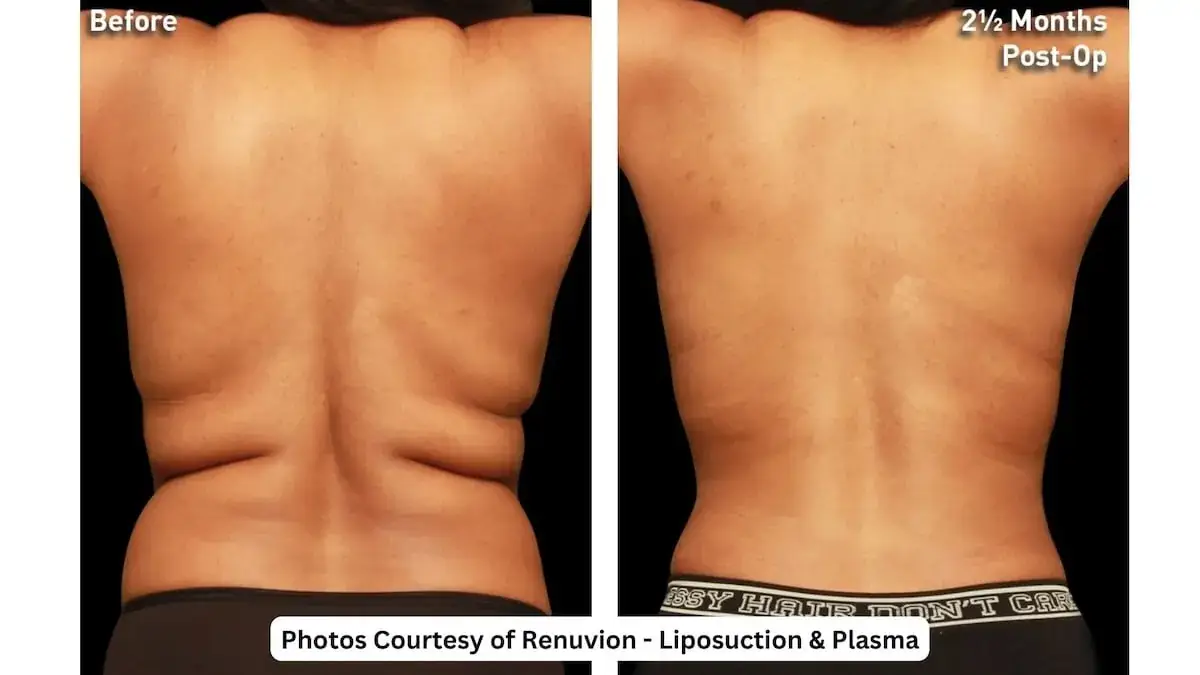
Choosing a Surgeon for Your J Plasma Liposuction Procedure
The first step toward achieving your desired body contour is undergoing a J Plasma and liposuction procedure. Finding the right Cosmetic Surgeon is key to a successful J Plasma liposuction procedure.
The Importance of Board-Certified Cosmetic Surgeons
Selecting a board-certified cosmetic surgeon ensures that you’re in safe hands. These surgeons have undergone rigorous training and examinations to attain their certification. They also adhere to strict ethical standards set by medical boards.
Beyond these qualifications, an ideal candidate for performing your J Plasma liposuction should possess substantial experience with the procedure itself. Remember, every patient’s body is unique and requires individualized care – something only experienced professionals can give.
Researching and Selecting a Cosmetic Surgeon
To start your search, consider asking friends or family who’ve had cosmetic surgery procedures before. Personal recommendations are often reliable sources of information as they provide real-life experiences from people you trust.
You can also leverage online platforms such as doctor review sites or even social media groups related to aesthetic medicine topics where previous patients share their experiences openly.
Book consultations with each one once you shortlist potential surgeons based on credentials and reputation.
In these sessions:
- Aim to get more insight into their treatment plan approach specific to J plasma lipo.
- Evaluate how comfortable you feel discussing concerns or queries.
- Gauge whether they value patient education around risks & benefits.
- Note if they discuss post-surgery recovery guidelines, including wearing compression garments.
Remember, it’s essential to feel comfortable and confident with your surgeon.
Understanding the Risks and Benefits of J Plasma Liposuction
Your selected surgeon must be upfront about the pros and cons of a J Plasma liposuction procedure. They should clearly detail how they apply cold plasma energy.
Cost Considerations for J Plasma Liposuction
The cost of J Plasma liposuction is a vital factor to consider when planning your cosmetic surgery. The cost of J Plasma liposuction may differ depending on the difficulty of the procedure, where it’s being done, and how experienced your surgeon is.
A unique aspect of this treatment plan is that it often combines traditional liposuction with plasma technology. This pairing means you’re not only paying for fat removal but also skin tightening benefits, which might raise costs compared to regular lipo.
While this might sound pricey initially, think about how you are essentially getting two procedures – fat removal and skin tightening – at once. The benefit? You save time and get firmer skin in treated areas without additional treatments later.
Paying for Your Procedure: Financing Options
Fear not if you’re worried about handling all costs upfront. Many clinics offer financing options for J Plasma liposuction procedures. These plans allow patients to pay off their treatment over time instead of making one large payment before the operation begins.
This flexibility helps make these advanced cosmetic surgeries more accessible to everyone seeking body contouring solutions or help with loose or sagging skin due to weight loss or gain.
Besides third-party healthcare credit companies like CareCredit, some practices may have internal financing schemes, too. It’s essential, then, during your initial consultation visit with a potential surgeon, to ask questions regarding the available finance routes they provide.
Weighing Up Cost vs Value
In weighing up whether undergoing J-plasma lipo is worth its price tag – remember that you’re investing in yourself. This procedure’s goal isn’t just removing stubborn fat deposits or treating loose skin; it’s also about boosting your self-esteem and confidence.
While J-Plasma liposuction may be more costly than traditional lipo, the investment can yield substantial returns on body positivity and happiness levels.
To wrap it up, getting a grip on the cost of J Plasma Liposuction and how to finance it is crucial.
FAQs About J Plasma Liposuction
Is J-plasma better than lipo?
J-Plasma liposuction has the edge over traditional lipo because it tightens skin while removing fat, offering more contoured results.
Is J-plasma with lipo worth it?
Combining J-Plasma with liposuction is worth considering if you’re seeking enhanced body contouring and skin tightening benefits.
What is J-plasma liposuction?
J-Plasma liposuction uses cold plasma energy to tighten skin after fat removal, leading to a smoother, firmer look post-liposuction.
How long do J plasma results last?
The effects of J-Plasma are lasting. Initial improvements show immediately and continue for up to nine months post-procedure.
Conclusion
- J Plasma liposuction, remember it. It’s the game-changer in body contouring and skin tightening you’ve been waiting for.
- Remember, it goes beyond traditional liposuction methods to tighten your skin – thanks to its unique combination with helium gas.
- Remember how minimally invasive this procedure is? The speedy recovery period implies you can return to your regular activities faster than ever!
- You’ll appreciate knowing that combining J plasma lipo with other procedures like tummy tucks or fat transfers can lead to even better results.
- In short, J plasma liposuction offers a revolutionary solution for those struggling with stubborn fat and loose skin. Now, go out there and make an informed decision about your body transformation journey!
What’s Next?
At Moein Surgical Arts, we specialize in cosmetic surgery and are here to guide you toward achieving your desired shape safely and effectively. Ready to take action? Please schedule a consultation, call 424-279-5801 seven days a week from 8 a.m. to 8 p.m., or fill out our contact form here.
The procedure removes stubborn pockets of body fat resistant to diet and exercise. While the aesthetic technique should not be considered a weight-loss method, liposuction can recontour your curves. The results could give you the body of your dreams. And as this article will show, liposuction could motivate you to want to live a healthier lifestyle.
First, let’s dispel some myths.
Myth #1: Liposuction is a One Size Fits All Procedure
You may not be aware but there are several different types of liposuction. Traditional lipo uses a tumescent fluid to reduce pain and bleeding. Then there is VASER liposuction, which uses sound energy to break up fat before it is suctioned away.
Traditional liposuction is useful for removing large pockets of fat. VASER is best for etching your body’s musculature and is popular with bodybuilders and fitness buffs.
Myth #2: Liposuction Produces Immediate Results
In a perfect world, your cosmetic surgeon would perform liposuction, and you would leave the office looking just as you expect. While lipo does produce amazing results, the aftereffects can take time to manifest fully.
You can experience swelling for days or weeks following your procedure. This is why cosmetic surgeons ask that you wear a compression vest, which aids with healing and reduces swelling. Once the swelling subsides, your new and improved look will shine right through.
Myth #3: Liposuction is the Safest Cosmetic Procedure
Let’s not mince words here. Liposuction is safe when performed by an experienced cosmetic specialist. That being said, lipo is still considered a surgical procedure. Your cosmetic surgeon will explain all the potential complications and risks during the initial consultation. It is important that you understand how liposuction can affect your health before signing up for the procedure. One of the most significant risk factors is a blood clot, which can travel through your bloodstream to your lungs or brain. This complication is incredibly rare. Other potential risks include infection, bruising, skin color alterations, and numbness. You can further reduce your risks of experiencing complications by choosing your cosmetic surgeon wisely.
Myth #4: Liposuction is Best Performed as a Standalone Procedure
You can certainly undergo lipo all by itself. The procedure can be used on many bodily areas, including the face, chin, neck, chest, back, arms, flanks, abdomen, buttocks, thighs, and ankles. However, liposuction can also be used alongside other procedures.
Myth #5: Liposuction is Useful for Loose Skin
Lax skin is a common complaint among cosmetic surgery patients. Age, significant weight loss, and genetics can lead to a loss of skin elasticity on the upper arms, abdomen, upper thighs, and elsewhere on the body.
Liposuction is useful for permanently removing fat cells, but traditional lipo will not tighten the skin. VASER liposuction, on the other hand, is effective at skin tightening. Traditional liposuction and VASER lipo can both be used alongside other procedures such as Renuvion. Renuvion uses J-plasma technology to coagulate tissues around the treatment area. When used with lipo, Renuvion can lead to slimmer, firmer arms and thighs. Another popular combination is liposuction used with the tummy tuck, which removes loose skin while also tightening the abdomen.
Does Liposuction Make You Healthier by Motivating You To Stay Fit?
Your Consultation Can be a Wakeup Call
For some people, preparing for liposuction, such as meeting with a surgeon, discussing the procedure, and going through recovery, can be a wake-up call to start taking your health more seriously.
Can Speed Up Recovery
Research shows that the best time to start a healthier lifestyle is immediately following your liposuction procedure. While you are encouraged to rest for around 48 hours, engaging in moderate activity and an anti-inflammatory diet can reduce swelling and lead to faster recovery.
An anti-inflammatory diet contains whole and unprocessed foods without added sugar. This means filling your plate with plenty of fruits, vegetables, legumes, whole grains, seeds, low-fat dairy, fish, poultry, and olive oil.
Gaining Weight Can Skew Your Results
Liposuction is considered a permanent cosmetic procedure. The fat is suctioned away and will not return. It should be noted that liposuction may not remove all fat cells from the treatment area. There could be some remaining fat cells that can grow in size and expand if you end up gaining weight. Following a liposuction procedure, putting on weight can lead to fat showing up in new and unpredictable places. The best way to prevent this from happening is to eat healthily and engage in regular exercise.
We have already covered what to eat to prevent inflammation after liposuction. It also helps to know which foods to avoid. These include fast foods, fried foods, sugary cereals, processed meats, and refined grains like pasta, rice, crackers, and bread.
As far as what to drink, consuming lots of water can never do you wrong. You may want to limit sodas and alcohol or cut them out entirely.
Regarding exercise, you will be limited to walking for a few weeks following surgery. Once your cosmetic surgeon has cleared you to resume physical fitness, you should begin (or continue) an everyday routine. You don’t necessarily have to hire a personal trainer, though that’s not the worst idea. You can also join a workout class, attend the gym regularly, build a home gym, or work out in your living room to YouTube videos. Regular activity is necessary to maintain your liposuction results and achieve a healthier lifestyle.
Soaring Confidence Makes You Want to Stay That Way
Liposuction can help you feel more confident and self-assured about your appearance. Feeling good about your appearance can inspire you to take better care of yourself.
Suppose you are a non-smoker, within 30% of your ideal weight, and you hold realistic expectations for what lipo can do for you. In that case, you may be an excellent candidate for this ever-popular cosmetic procedure.
Tips for Living Healthier After Liposuction
In the book Liposuction: The Big Fat Story, Sunitha Raj offers good advice for starting on the ball early. “Start off on an exercise regimen and diet modification well before the surgery. Make a promise to yourself: you will continue to look after your body and stick to the pre-surgery regime for as long as you live. Liposuction is the nudge that will help you to a healthier lifestyle. That should be your commitment to you.”
Reduce Carbohydrates
Your cosmetic surgeon recommends avoiding carbs for at least six weeks after your liposuction procedure. For best results long into the future, you may want to consider limiting your intake of carbohydrates for the rest of your life.
Supplement Your Diet
Taking supplements can assist with liposuction recovery. Pay special attention to foods and tablets that contain vitamin D and magnesium. Vitamin D boosts the creation of cathelicidin in the body. This peptide helps to fight off infections. Magnesium fights inflammation. You can find these nutrients in avocados, spinach, bananas, dark chocolate, kidney beans, egg yolks, and sardines.
Probiotics can help to protect against infection after liposuction surgery. Foods to include in your diet include miso, kefir, kimchi, pickles, yogurt, and kombucha.
Lower Your Stress Levels
You can do everything right, but if you are overly stressed, you can engage in unhealthy habits, like overeating. Too much stress can spike your cortisol levels, which signals your body to store more fat. Stress can also affect cravings, making you want salty and fat-filled junk foods. You can minimize stress by getting enough sleep, meditating often, and practicing self-care.
Avoid a Sedentary Lifestyle
We have established that you can achieve a healthier lifestyle by eating right and moving your body. The opposite is to live a sedentary lifestyle, which should be avoided at all costs. According to experts, sitting for too long is detrimental to your health, as much as smoking.
No matter your station in life, there are tips you can follow to become more active following your liposuction procedure. If you work at a desk all day, strive to stand up and move your legs at least once every half-hour. You can walk around the office or up and down the hallway, even for a brief time. Set a timer to keep yourself accountable.
You can also consider getting a standing desk so that you’re not sitting on your behind all day. Doing so can cause certain parts of you to sag over time. Even if you don’t have a standing desk, you might try standing for phone calls and taking the stairs instead of the elevator.
No Smoking
Smoking is bound to come up during your initial consultation with a liposuction specialist. Your cosmetic surgeon will encourage you to stop smoking at least two weeks before your surgery date. This is not because your surgeon is allergic to smoking or doesn’t want to smell the smoke in the operating room. The reason is that smoking is horrible for your health, particularly as you recover from liposuction.
Smoking can slow healing and skew your results. Even after you recover, smoking is never a good idea. Use your liposuction results as motivation to quit permanently.
Make Living Healthily a Habit
You probably do not need to be told that yo-yo dieting harms your health. Losing weight on a crash diet only to gain it back again is hard on your body. The problem with crash diets is that you tend to surrender to unhealthy temptations once you have reached your goal. Sometimes, you become tempted even if you don’t reach your goal. Either way, you only face packing the weight you’ve lost back on.
The better way to approach healthier living is to build healthy habits. Find healthy foods to eat that you enjoy eating. Search online for recipes involving many of the foods we have already mentioned. Instead of dieting briefly, learn to enjoy and prefer healthy foods. Instead of exercise that you force yourself to do, find physical activities that you enjoy and look forward to. You are even encouraged to involve friends to make your healthier habits a social affair.
Track What You Eat and Drink
This tip can coincide with your attempt to build healthier habits. If you are straying from healthy eating and regular exercise, hold yourself accountable by tracking what you eat and how you move. You can either keep a food and exercise diary or download an app. Countless apps help you count calories, track your exercise, as well as log your water intake. Some apps even gamify the process, letting you see how much you’ve progressed while making healthy living fun.
Make This the Year You Live Healthily with Liposuction
It’s a new year, which means it’s an opportunity to create a whole new you. By now, you know that liposuction can be used on various bodily areas, from the head to the ankles. You also have myriad tips for maintaining your liposuction results. Use this advice to create a slimmer, healthier version of yourself.
Want to learn more?
Schedule a liposuction consultation with renowned cosmetic surgeon Doctor Babak Moein by calling Moein Surgical Arts at (310)694-4486.
Read More
]]>The recovery process post-liposuction is unique to each individual, and knowing what to expect on this journey can help alleviate any anxieties. This guide aims to provide an in-depth look at liposuction results week by week, helping you navigate through your healing phase with confidence and clarity.
We will explore details about how your body heals after the surgery, managing discomfort during the initial days, the importance of compression garments, and more. So let’s get started!
Table of Contents:
- Decoding Liposuction Results Week by Week
- Week 1: Immediate Post-Op Period
- FAQs in Relation to Liposuction Results Week by Week
- Conclusion
- What’s Next?
Decoding Liposuction Results Week by Week
Navigating the path to successful liposuction results week by week requires a keen understanding of the recovery process. The aftermath of your procedure is not merely about healing but also about how your body transforms over time.
A Deep Dive into Liposuction Recovery Basics
Significant changes in your body characterize the first few weeks post-op liposuction as it heals and adapts. This phase is crucial in achieving and sustaining the desired outcomes for an extended period.
In 2023 alone, over 211,000 individuals opted for liposuction procedures across America. Such figures highlight the importance of refining the recovery timeline while ensuring patient comfort during this critical stage.
Your body’s response following surgery becomes evident within days after your fat removal. Symptoms like bruising or swelling may occur; however, these are normal reactions that subside as tissues adjust post-procedure. Your healthcare provider will guide you through managing any discomfort associated with these symptoms throughout this crucial initial week of recovery.
Impact of Different Types Of Liposuctions on Recovery Timeframes
Diverse types of liposuctions can influence how quickly one recovers from surgery and when noticeable improvements begin to surface. Tumescent liposuction stands out among others due to its unique technique involving large volumes of fluid injection before extraction takes place – influencing different recovery timelines compared to other methods.
An alternative approach includes ultrasound-assisted procedures, which utilize sound waves to liquefy fat cells before their removal—potentially minimizing trauma inflicted on surrounding tissues, thus affecting healing times differently than traditional techniques such as tumescent lipo. Given all variations considered, it remains vital for patients seeking treatment to understand each method’s intricacies thoroughly enough so they can anticipate treatments based on individual needs and expectations around outcomes, too.
Having dissected some fundamental aspects regarding what influences one’s journey through weeks post-op liposuction, let us delve deeper into specifics starting at ground zero—the immediate aftermath right after having undergone surgical intervention itself.
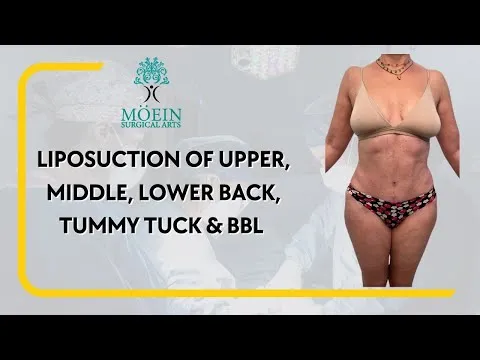
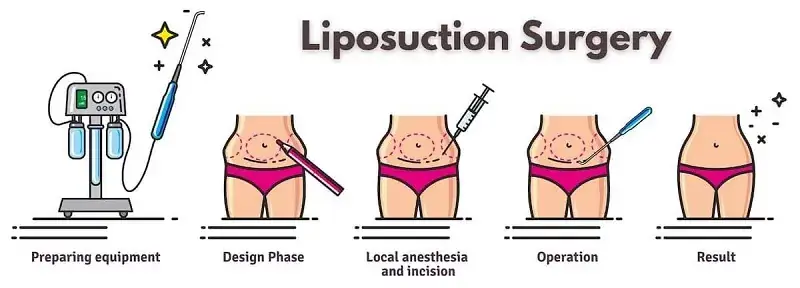
Week 1: Immediate Post-Op Period
The first week after your liposuction surgery is crucial for kick-starting healing. This phase generally includes managing post-op pain and beginning to observe preliminary changes in body shape.
Managing Pain After Surgery
After liposuction, you may experience discomfort, which can vary based on individual thresholds and the amount of fat removed during surgery.
Your surgeon will provide appropriate pain medication, ensuring comfort and fostering an optimal healing environment for your body when taken as directed.
Maintaining transparent communication with your surgical team about any unexpected increases in pain or concerns can help them adjust treatment plans accordingly, ensuring a comfortable recovery journey throughout this critical phase.
Importance of Compression Garments
In addition to following prescribed medication schedules, wearing compression garments plays a pivotal role in the early stages of recovery from liposuction procedures. These snug-fitting pieces are multi-functional; they reduce swelling by exerting consistent pressure across treated areas while aiding in improving overall contour results by keeping tissues firmly anchored during their healing period following the disturbance caused by surgery.
Research indicates that patients who diligently adhere to their compression garment regimen tend to experience smoother outcomes with fewer visible irregularities than those who do not strictly follow garment-use instructions.
Tumescent liposuction – currently deemed the most common type of procedure according to recent statistics – often necessitates extended periods of wearing these garments due to its unique method involving large amounts of injected fluid before fat extraction. Therefore, adherence becomes even more significant if you’ve undergone this particular variant. If you had VASER high-definition liposuction, your instruction would include a foam mold to wear for at least the first week.
You should consult with your doctor about how long you need to keep it on based on personal circumstances and the type of procedure performed.
This ensures the best possible outcome when moving into the next phases, where effects become more apparent weekly.
Week 2-3: Early Recovery Phase
The weeks following a liposuction procedure are crucial for the healing process. As you navigate through the second and third weeks post-operation, your body continues its journey toward recovery, revealing preliminary glimpses of your new physique.
During this period, changes to your physical appearance become more apparent as swelling decreases and bruising starts to fade away. It’s essential to remember that outcomes can differ depending on age, health condition, habits, and following post-op care instructions.
Observing Changes in Swelling and Bruising
In the aftermath of a liposuction surgery during the second week onwards, you’ll likely witness substantial reductions in swelling. Although some inflammation might persist for several weeks or months, depending on personal healing timelines, most patients report noticeable improvements during this phase.
Bruises also begin to transform around this time frame. The initial deep purple or blue hues start shifting into lighter shades of yellow or green before completely vanishing. This color change indicates successful tissue repair happening beneath the skin surface.
Pain Management & Mobility Improvements
As we progress into weeks two and three after liposuction surgery, pain levels should notably decrease, if not earlier, with proper medication management under medical supervision. Discover more about managing discomfort during liposuction recovery here.
Aiding mobility improvement is another positive aspect associated with reduced pain – an encouraging sign that enables patients to gradually resume daily activities within prescribed limits set by their surgeon.
Gentle Exercise: Boosting Circulation And Accelerating Recovery
Beyond maintaining good nutrition, engaging in gentle exercises can help enhance circulation, promoting faster recovery. Simple activities like short walks at home and stretching exercises are generally safe, but always consult your doctor before starting any exercise regimen post-surgery. Check out our recommendations for exercising after lipo here.
FAQs About Liposuction Results Week by Week
Liposuction Results Week by Week: Your Recovery Journey
When undergoing liposuction, it’s natural to wonder about the timeline for seeing results. While initial changes may be noticeable right after the procedure, the outcome becomes more apparent as swelling subsides. Typically, this occurs around 1-3 months post-procedure.
Why Do I Look Bigger 3 Weeks After Liposuction?
If you notice that you appear bigger a few weeks after liposuction, don’t panic. This is a common occurrence due to swelling and fluid retention during the early stages of recovery. As your body heals, these effects gradually reduce over time, revealing the true results of the procedure.
Are You Still Swollen 2 Weeks After Liposuction?
Yes, it’s completely normal to experience some degree of swelling for several weeks following a liposuction procedure. The extent of swelling varies depending on individual healing rates and the complexity of the surgery. Patience is key during this stage of the recovery process.
What to Expect 5 Weeks After Liposuction?
By the fifth week after liposuction, you may notice a further reduction in swelling and a gradual improvement in body contouring. It’s important to continue attending regular follow-up appointments with your surgeon to ensure
Conclusion
- With the right knowledge and guidance, it becomes manageable.
- The initial post-op period may bring discomfort, but pain management is key to a smooth recovery.
- In weeks two to three of your healing journey, you’ll start noticing changes as your body adapts and heals from the procedure.
- Different types of liposuctions can influence how fast or slow this process might be. Remember that each individual’s recovery timeline varies based on numerous factors, including health.
- Liposuction is more than just a cosmetic treatment; it’s a journey towards self-confidence and improved physical appearance. With over 211,000 procedures performed in the US alone last year, its popularity continues to grow!
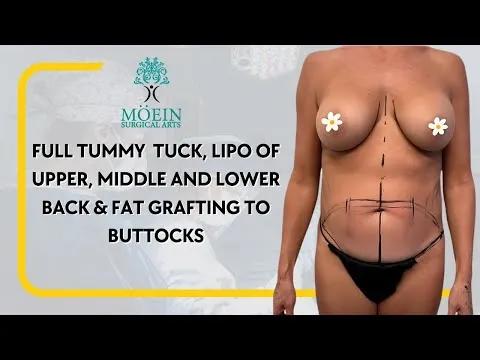
What’s Next?
At Moein Surgical Arts, we specialize in cosmetic surgery and liposuction and are here to guide you toward achieving your desired shape safely and effectively. Ready to take action?
Please schedule a no-obligation consultation. Call 424-279-5801 seven days a week from 8 a.m. to 8 p.m., or fill out our contact form here.
When it comes to body contouring and achieving that desired shape, a hurdle is… making this decision. It can feel like standing at the crossroads of Tummy Tuck and Liposuction, unsure of which path will lead you to your dream silhouette. But here lies the difference between those who keep dreaming about their ideal body shape and those who take action toward achieving it.
Consider Jane – she lost significant weight but was left with sagging skin around her abdomen. She thought liposuction would be enough until she learned more about tummy tucks. The concern of making the wrong choice has her second-guessing her options now! Can you relate?
To make an informed decision on whether to go for a tummy tuck vs liposuction or both…you need all the facts.

Tummy Tuck Vs Liposuction: An Overview
Ever wondered about the difference between Tummy Tuck vs Liposuction? Or perhaps you’re curious about which procedure might suit your unique body goals. In this world of cosmetic procedures, it’s essential to understand that while both these surgical interventions aim at enhancing one’s physical aesthetics, they serve distinct purposes.
Liposuction, commonly called lipo, targets stubborn pockets of fat deposits resistant to diet and exercise. It involves making small incisions through which a Cosmetic Surgeon uses suction techniques to remove unwanted fat cells from specific areas like love handles or the lower back. The primary goal here isn’t weight loss per se but rather reshaping the body by removing fatty tissue.
On the other hand, a debate on tummy tuck vs liposuction often arises when individuals seek fat removal, skin tightening, and muscle repair. A tummy tuck, or abdominoplasty, removes excess skin and tightens abdominal muscles, making it ideal for those who have experienced significant weight loss or pregnancy-related changes.
Understanding the differences between tummy tuck vs liposuction is crucial in choosing the correct procedure for your aesthetic goals. While liposuction is best for sculpting and contouring, a tummy tuck provides more comprehensive abdominal tightening and reshaping. Consulting with a qualified surgeon can help determine which procedure fits best with your desired results.
Tackling Excess Skin with Abdominoplasty
Moving to tummy tucks, medically known as abdominoplasty – we see an entirely different focus area. A mini tummy tuck surgery targets sagging skin and excess fat around the belly button towards the lower abdomen region. A full tummy tuck focuses on excessive skin, fat and often muscle plication above the waist.
A board-certified cosmetic or Cosmetic Surgeon makes a horizontal incision across this area and removes excess skin. In the case of a full tuck, they often tighten weakened abdominal muscles while also getting rid of any extra skin left behind after significant weight loss or pregnancy – offering patients a flatter-looking stomach. A full tuck may or may not require muscle repair, but it often does.
The Decision Factor Between Liposuctions and Tummy Tucks

So, what should be your choice between these two options? Much depends on individual needs and objectives discussed during consultation sessions with your chosen Cosmetic Surgeons.
Liposuction could be your go-to choice if localized pockets of stubborn fats bother you most, given its contouring results. If skin looseness is slight and your skin has good elasticity, non-surgical skin tightening may be an option.
On the other hand, if loose skin is more prevalent post substantial weight reduction, aging, or childbirth events, opting for a tummy-tuck would make better sense since it addresses excess fas and tackles saggy skin too. Note: skin with stretch marks has broken elasticity and does not snap back after liposuction.
We’ll delve deeper into each process involved, including recovery times required post-surgeries in subsequent sections so stay tuned.
The Surgical Procedures Explained
So, you’re considering a cosmetic procedure to enhance your appearance. What procedure should you choose? Let’s dive deeper into the specifics of two popular options: liposuction and tummy tucks.
The Liposuction Procedure
Liposuction has been a go-to choice for many looking to remove unwanted fat from stubborn areas like love handles or lower back. It all starts with small incisions made by an experienced board-certified Cosmetic Surgeon in targeted spots where those pesky fat deposits reside.
This relatively non-invasive procedure aims to reshape specific body parts by removing resistant pockets of excess fat that dieting or exercise can’t seem to touch or deposited in places determined by genetics that create a square vs. curvy shape. For more details about what happens during liposuction surgery, click here.
The Tummy Tuck Procedure
Depending on the type of tummy tuck (or abdominoplasty), it can go beyond just dealing with loose skin; it also tightens weakened abdominal muscles giving your midsection an overall firmer look. This process involves making a horizontal incision across your lower abdomen – its length depends on how much skin needs removal and how separated the muscle is. In the case of a mini tuck, designed to address skin below the navel, the incision tends to be shorter, but again, it is determined by how much skin needs to be removed and how long it has to be to ensure the scar is flat.
Your newly tightened muscle layer gets redraped with skin that has been trimmed, ensuring smoother contours for that flatter belly button area we all desire. Click here to learn more about typical steps during a full-fledged tummy-tuck session.
Comparing Costs Between Liposuction and Tummy Tucks
With cosmetic procedures, understanding financial commitment is crucial to your decision-making process. There is a disparity in average costs regarding Tummy Tuck Vs Liposuction surgery.
Liposuction – primarily designed for removing unwanted fat from targeted areas like love handles or lower back – averages in the LA area between 7K and 18K, depending on the procedure’s extent and if body sculpting is involved. Full 360 high-definition liposuction body sculpting would naturally cost more than liposuction for a few debulking areas. This figure can fluctuate based on several factors, such as:
- How much fatty tissue needs removal
- Where you’re having the procedure performed
- Whether you have traditional vs. VASER high-def lipo (body sculpting)
- If you have abdominal etching
- The demand for the surgeon
The Financial Implication Of A Tummy Tuck Procedure
At 8K to 20K for a complicated fleur-de-lis tuck done after massive weight loss, getting that flatter tummy via abdominoplasty costs significantly more than lipolysis alone (fat cell destruction). It depends if the procedure involves eliminating excess skin or tightening abdominal muscles, which makes it somewhat complex compared with simpler surgical operations aimed solely at eliminating fat deposits within body contours.
This surgical procedure requires general anesthesia and longer operating times due to both complexities involved in removing sagging skin from the lower abdomen while simultaneously tightening loose abdominal wall muscles through a horizontal incision made across the belly button region – hence justifying its higher price point relative to other simpler cosmetic procedures like lipo-surgical operations targeting localized adipose deposits specifically.
Getting further insights into why achieving desired results, such as tighter abs, might require a greater investment than regular lipo-surgical operations. Sometimes undergoing both procedures might be beneficial or necessary, especially when large amounts of unwanted fats must be removed, followed by addressing any resultant loose skin left behind after significant weight loss achieved either naturally or post-bariatric surgeries. As a rule, most surgeons will adjust the costs lower if both procedures are done in one surgery, saving time and expense in the operating room.
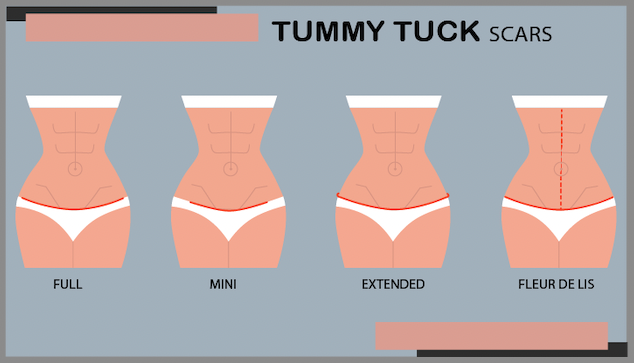
Ideal Candidates for Each Procedure
Deciding between a tummy tuck and liposuction for cosmetic purposes can be intimidating. The key lies in understanding who makes an ideal candidate for each procedure.
Liposuction: For Those Seeking Fat Removal
The primary goal of liposuction surgery isn’t necessarily weight loss but slimming specific areas of your body by removing excess fatty tissue. This might be your go-to solution if you have stubborn pockets of unwanted fat around love handles or lower back that refuse to budge despite diet and exercise efforts. It will give you a curvier you!
A crucial determinant here is skin elasticity; if you possess firm, elastic skin, chances are higher that post-surgery results will be more satisfactory as such type of dermis naturally conforms to new bodily contours following removal of fat cells. If minor skin redundancy is a concern, ask about non-surgical skin tightening with j-plasma technology.
Tummy Tuck: Beneficial for Loose Skin After Weight Loss or Pregnancy
If sagging abdominal muscles along the belly button area bother you due to drastic changes like massive weight reduction or childbirth, aging or stretch marked skin, then a tummy tucks procedure is necessary.
You will make perfect candidates if you have a stable weight yet deal with droopy midsections caused by aging factors, pregnancies or successful weight loss. Remember though – always keep expectations realistic about what these surgeries could accomplish; they should never replace healthy lifestyle habits.
In Consultation With Your Trusted Cosmetic Surgeon
No matter which treatment seems most appealing based on these criteria above, consulting expert advice remains paramount before making decisions regarding plastic surgery operations. Your surgeon will assess individual situations thoroughly, considering health status, medical history, and combined aesthetic goals for effective outcomes in personalized treatment plans.
Liposuction vs Tummy Tuck Results?
Diving into the world of cosmetic procedures can feel like navigating a labyrinth. However, when you break it down, understanding what to expect from liposuction and tummy tuck surgery is pretty straightforward.
Let’s recap the difference between the procedures.
Liposuction Results: The Skinny on Fat Removal
You’ve decided to undergo liposuction surgery. So how does this procedure transform your body? It zeroes in on stubborn fat deposits that refuse to budge despite dieting or exercise. Post-surgery, patients usually see an impressive reduction in these fatty areas resulting in improved overall body shape.
However, remember one important fact about liposuctions – while the removed fat cells don’t return, if there is significant weight gain post-surgery, fat in other parts of your body gets much bigger. Hence maintaining a stable weight through healthy lifestyle choices becomes crucial for preserving those sleek results long-term.
Tummy Tuck Results: Unveiling Your Flatter Abdomen
A tummy tuck procedure, also known as abdominoplasty, goes beyond just removing excess skin and unwanted fat; it tightens weakened abdominal muscles too.
- The result? A flatter abdomen with enhanced muscle tone makes your midsection more defined.
- In contrast with liposuction, where future weight gains could potentially impact results negatively, once fully healed after undergoing a tummy-tuck, barring massive fluctuations due to pregnancy or excessive weigh-gain, your newly tightened abdominal wall should remain relatively unchanged over time thanks largely part underlying muscular support structure now place prevent potential sagging issues arising later line. That is not to say that visceral fat gained would not push the muscles forward.
- This invasive surgical procedure offers greater permanence compared to its less-invasive counterpart.
Potential Complications & Risks
Every surgical operation, including liposuction and tummy tucks, may have its possible issues and dangers. It’s crucial to understand these before you decide which cosmetic procedure is the right choice for your body.
Liposuction Risks
Liposuction surgery offers an effective solution in a world where everyone wants quick fixes to get rid of unwanted fat deposits in areas like love handles or lower back. However, it does come with certain risks, such:
- Infection
- Scarring
- Fat embolism – loosened fat enters the bloodstream causing blockages
A study on PubMed also highlights that patients may experience temporary swelling or numbness post-surgery along with bruising at incision sites used during this invasive procedure.
Tummy Tuck Risks
If loose skin around your abdominal area bothers you more than small pockets of excess fat, then a tummy tuck might be what you need instead. But remember: This isn’t just about removing sagging skin from the lower abdomen region but also tightening up those lax abdominal muscles through horizontal incisions across the belly button level (or slightly below). And while results can indeed give flatter tummies, additional risk factors are also associated here.
The American Acadamy of Cosmetic Surgery has identified several possible issues arising out postoperative period following abdominoplasty procedures. These include poor wound healing leading to visible scars around the navel area. Also, changes in sensation due to nerve damage operation could occur over time. So make sure to discuss all these points in detail board-certified cosmetic surgeon planning phase itself so that there are no surprises later down the line.
Making Informed Decisions With Your Board-Certified Cosmetic Surgeon
To ensure safety throughout the entire process, starting pre-operative consultations until the recovery period following the actual surgical intervention itself, working closely with board-certified Cosmetic Surgeons who specialize in types of surgeries becomes essential to achieving desired physical improvements effectively and safely without compromising the health and well-being of patients overall.
When Combining Both Procedures Makes Sense
Combining cosmetic procedures to achieve optimal results can be advantageous rather than simply choosing between the two. Sometimes, combining treatments can be beneficial to achieve optimal results and meet patient expectations.
The concept here is simple: use each procedure where they shine most – Liposuction removes unwanted fat deposits, while a Tummy Tuck tightens sagging skin and strengthens weakened abdominal muscles.
Liposuction & Tummy Tucks: A Powerful Duo?
If you’ve been grappling with stubborn fatty tissue in areas like your love handles, belly, bra area, or lower back that diet and exercise won’t shift, then liposuction surgery could be your answer. However, if lipo leaves behind loose skin, that will require further attention.
Selecting Your Procedure(s): An Informed Decision Is Key.
Whether one should opt for both procedures depends largely on personal goals and professional advice from their chosen board-certified cosmetic surgeon.
FAQs in Relation to Tummy Tuck Vs Liposuction or Both
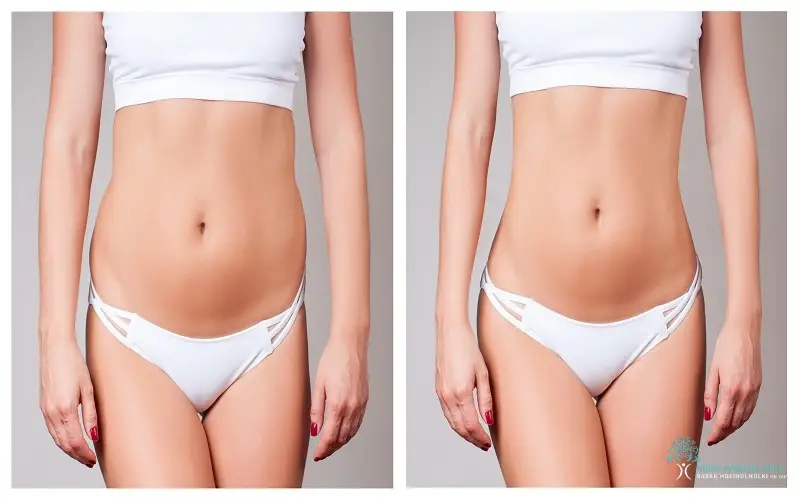
Should I get liposuction or a tummy tuck?
Your choice between liposuction and a tummy tuck depends on your specific goals. Liposuction is ideal for removing small fat deposits, while a tummy tuck addresses loose skin and strengthens the abdominal wall.
What removes more fat: a tummy tuck or liposuction?
Liposuction specifically targets larger fat removal volumes than a traditional Tummy Tuck. However, combining both procedures can optimize results when dealing with substantial unwanted fat, muscle separation and sagging skin.
What is better than a tummy tuck?
No procedure is universally “better” than another; it depends on individual needs. For instance, if you have good skin elasticity but struggle with stubborn belly fat, then liposuction might be more suitable for you than a Tummy Tuck.
What is the best surgery for belly fat?
The best surgical option for belly fat largely depends on your personal circumstances. Liposuction effectively removes localized pockets of excess adipose tissue, whereas abdominoplasty (tummy tuck) is optimal when addressing excessive loose abdominal skin.
Final Thoughts: Tummy Tuck
vs Liposuction
Embarking on the body contouring journey can feel like standing at a crossroads. Tummy tuck or liposuction, which path will lead you to your dream silhouette? You’ve learned that these procedures aren’t interchangeable.
- The surgical process differs, too—small incisions for liposuction contrast with the more invasive horizontal cut required for a tummy tuck.
- Recovery times vary – seven to fourteen days post-liposuction versus three to four weeks following a tummy tuck.
- Costs differ significantly between these procedures
- The ideal candidate profile can differ
- Both surgeries offer lasting changes, but weight gain could affect outcomes differently after each procedure
- Your results expectations should be based on being fully informed so that you know what to expect
- Potential complications exist with any surgery so being aware is critical in making an informed decision.
Sometimes combining both procedures makes sense if you want to remove large amounts of unwanted fat and tighten loose skin left behind.
Deciding between tummy tuck vs liposuction or considering both? It’s all about what’s right for YOU!
What’s Next?
If this feels overwhelming, don’t worry! At Moein Surgical Arts, we specialize in cosmetic surgery and are here to guide you toward achieving your desired shape safely and effectively. Ready to take action? Please schedule a consultation, call 310-455-8020 seven days a week from 8 am to 8 pm, or fill out our contact form here.
For more information on what to expect after liposuction, read our blog Liposuction After Four Weeks – What To Expect.
]]>
Understanding Neck Liposuction
Neck liposuction is a procedure designed to remove excess fat from the neck and jawline, resulting in a more defined and sculpted appearance. It is a minimally invasive technique that uses small incisions and specialized tools to target and suction out unwanted fat deposits. This procedure is ideal for individuals with good skin elasticity and a well-defined jawline but struggling with stubborn fat in the neck area.
The Procedure
The neck liposuction procedure typically begins with administering local anesthesia or sedation to ensure the patient’s comfort. At Moein Surgical Arts, we offer Pro-Nox sedation as well. Once the anesthesia takes effect, the surgeon strategically places small incisions in inconspicuous areas, such as under the chin or behind the ears. These incisions allow for inserting a thin, hollow tube called a cannula.
The surgeon gently moves the cannula beneath the skin, carefully targeting and suctioning out the excess fat cells. The process requires skill and precision to ensure a smooth and even contour. Once the desired amount of fat has been removed, the surgeon closes the incisions with sutures, and a compression garment may be applied to minimize swelling and aid in the healing process.
If the procedure is being done with Renuvion J-Plasma skin tightening, that is completed before closing the sutures.
Enhancing Neck Liposuction with Renuvion J-Plasma
In recent years, a revolutionary technology called Renuvion J-Plasma has gained popularity as an adjunct to neck liposuction. This innovative device utilizes a combination of helium plasma and radiofrequency energy to tighten and rejuvenate the skin in the treated area. When used in conjunction with neck liposuction, Renuvion J-Plasma can provide enhanced results, particularly in addressing loose skin under the chin.
Renuvion J-Plasma delivers a controlled stream of energized helium plasma directly to the treatment area through a small incision. When activated by radiofrequency energy, the helium plasma causes immediate contraction and tightening of the underlying tissues, stimulating collagen production and promoting long-term skin rejuvenation. This dual-action technology offers patients a minimally invasive alternative to more invasive procedures, such as a neck lift, while achieving significant skin tightening effects.
The procedure involving Renuvion J-Plasma is typically performed immediately following neck liposuction. After removing excess fat, the J-Plasma device is carefully maneuvered beneath the skin, delivering the energy precisely to the target areas. The controlled thermal effect of the device helps to firm and tighten the skin, improving the overall contour and profile of the neck and jawline.
One of the significant advantages of Renuvion J-Plasma is its ability to provide noticeable results with minimal downtime. While there may be some swelling and bruising post-procedure, patients can generally resume their regular activities within a few days. The skin tightening effects continue to improve over the following months as collagen production is stimulated, leading to a smoother and more youthful appearance under the chin.
It is important to note that Renuvion J-Plasma is not suitable for everyone, and a thorough evaluation by a qualified Cosmetic Surgeon is necessary to determine candidacy. The surgeon will assess factors such as skin laxity, elasticity, age, and the patient’s overall goals to determine the most appropriate treatment plan.
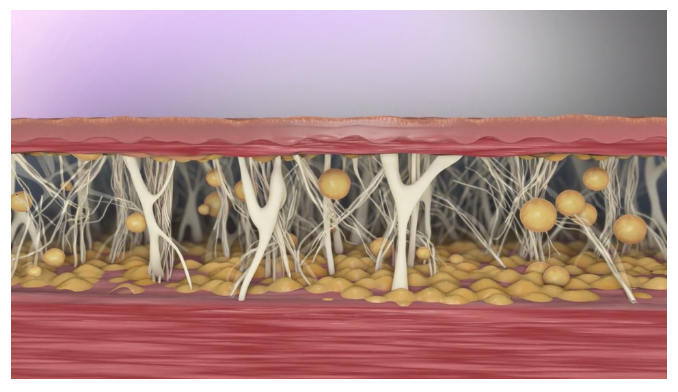
Recovery and Post-Procedure Care
Following neck liposuction, patients can expect some swelling, bruising, and discomfort, common after any surgical procedure. The surgeon may prescribe pain medication to manage any discomfort experienced during recovery. It is essential to follow the post-procedure care instructions provided by the surgeon, which may include wearing the compression garment for a few weeks and avoiding strenuous activities.
While the recovery time varies for each individual, most patients can resume their normal activities within a week or two. However, it is crucial to note that complete healing and final results may take several months as the swelling subsides and the tissues settle into their new contour. During this period, it is essential to maintain a healthy lifestyle, including a balanced diet and regular exercise, to maintain the results achieved through neck liposuction.
Potential Risks and Complications
Like any surgical procedure, neck liposuction carries certain risks. It is crucial to have a thorough consultation with a qualified and experienced cosmetic or Cosmetic Surgeon who can assess your suitability for the procedure and discuss any potential risks specific to your case. Some potential risks and complications associated with neck liposuction include infection, bleeding, asymmetry, changes in skin sensation, and scarring.
Choosing a reputable and board-certified Cosmetic Surgeon with a proven track record in neck liposuction can significantly minimize these risks and help ensure a successful outcome. Remember, an open and honest discussion with your surgeon about your expectations and concerns is vital for a satisfactory result.
Expectations and Results
Neck liposuction can improve the contour and profile of the neck and jawline. However, having realistic expectations and understanding the procedure’s limitations is crucial. While neck liposuction effectively removes excess fat, it may not address loose skin or muscle laxity issues. Renuvion can address skin laxity for many patients but is ineffective if the skin is excessive or the patient is older with little elasticity.
In some cases, additional procedures, such as a neck lift or skin excision, may be recommended to achieve optimal results.
What’s Next?
Neck liposuction, combined with advancements such as Renuvion J-Plasma, offers individuals a highly effective solution for addressing excess fat and loose skin under the chin. By choosing a skilled and experienced surgeon, patients can achieve a sculpted and youthful appearance, boosting their self-confidence and overall satisfaction with their appearance. As with any cosmetic procedure, thorough research, consultation, understanding of the procedure, recovery, risks, and expected results are essential to make an informed decision. If you are considering neck liposuction, consult an experienced cosmetic surgeon to determine if this procedure is right for you and explore the possibilities of incorporating Renuvion J-Plasma to enhance your results.
To explore your options, to discuss neck liposuction price, and ti schedule a complimentary consultation with Dr. Moein today. Call 424-279-5801 seven days a week from 8 am to 8 pm. Or fill out our Consultation Form, and we will contact you!
]]>We will also discuss the ideal candidates for this innovative procedure and explore high-definition awake lipo techniques from renowned Cosmetic Surgeons in Beverly Hills. Furthermore, we’ll examine how awake liposuction can effectively target various problem areas on the body while highlighting some limitations associated with the tumescent technique used in these procedures.
By understanding the intricacies of awake liposuction in Los Angeles, you’ll be better equipped to decide whether this cutting-edge cosmetic treatment is right for you.
Awake Liposuction: A Safer Alternative
Awake liposuction is a popular and innovative cosmetic surgery procedure in Los Angeles that allows patients to undergo treatment while remaining fully conscious. This less invasive method saves money, has a faster recovery time, and is considered safer than traditional liposuction performed under general anesthesia. Performed using local anesthesia, such as the tumescent technique, awake liposuction involves administering a sterile saline solution with diluted lidocaine and epinephrine into the fatty tissue.
Tumescent Technique for Reduced Pain and Discomfort
The tumescent technique used by your Los Angeles Cosmetic Surgeon reduces pain and discomfort during the procedure. The local anesthetic ensures you remain comfortable throughout the process without general anesthesia or sedation. This method is also commonly used in other medical procedures, such as wisdom tooth extractions and dental surgeries.
Better Patient Positioning Compared to Full Unconsciousness
One of the advantages of awake procedures like this one is better patient positioning during surgery. Unlike conventional surgery, where patients are unconscious due to general anesthesia, those undergoing awake surgeries can communicate with their surgeon about any discomfort they may be experiencing or make adjustments if needed. This active participation leads to more accurate results since it’s easier for your Cosmetic Surgeon to assess how much excess fat needs removal when you can provide feedback in real-time.
If you’re considering getting rid of stubborn fatty deposits through cosmetic surgery but have concerns about being put under general anesthesia, consider opting for awake lipo instead. Suppose you would like to learn more about this revolutionary approach or schedule a consultation at our surgical center in Beverly Hills. In that case, you can contact Dr. Moein today. Dr. Moein is a comfortable surgeon who regularly performs awake procedures such as breast augmentation and simple surgical procedures.
The Origins of the Awake Tummy Tuck Technique
Introduced by Dr. Juarez Avelar in 1999, the Awake Tummy Tuck technique revolutionized body sculpting procedures by eliminating general anesthesia without compromising stunning results. Pacific Rejuvenation Medical Plastic Surgery Specialist combines advanced medical technology with their expertise to offer awake liposuction as a safer alternative for achieving dream bodies.
Elimination of General Anesthesia Risks
A significant advantage of this innovative procedure is that it reduces risks associated with general anesthesia. Patients undergoing traditional liposuction often face complications such as blood clots, infection, and adverse reactions to anesthesia drugs. However, these risks are minimized when opting for an awake lipo procedure at Los Angeles Cosmetic Surgeon clinics like Moein Surgical Arts since local anesthesia is used instead.
Stunning Results Without Major Surgery
In addition to being a safer option than conventional surgery methods, awake liposuction delivers impressive outcomes without requiring major surgical intervention or extensive downtime post-procedure. Using tumescent fluid injections containing diluted lidocaine and epinephrine into fatty tissue areas targeted for removal during treatment sessions performed under local anesthetic ensures patients experience minimal discomfort while obtaining optimal fat reduction results from their cosmetic surgery journey at Beverly Hills surgical center conveniently located near downtown LA area attractions like Rodeo Drive shopping district among others popular tourist spots around town.
Ideal Candidates for Awake Liposuction
Awake Liposuction is perfect for those who want to remove stubborn fat deposits without undergoing major surgery or risking complications associated with general anesthesia. Recovery times are minimal compared to traditional methods since there’s no need for hospitalization or extensive post-operative care.
Suitable BMI Range for Awake Liposuction
The ideal candidate for awake liposuction should have a Body Mass Index (BMI) within the range of 36-42, as this procedure is designed to target localized fatty deposits rather than serve as an overall weight loss solution. Patients must also be in good health and have realistic expectations about the results they can achieve through cosmetic surgery.
Minimal Recovery Time Due to Lack of Hospitalization
- Faster Healing: Since awake liposuction uses local anesthesia instead of general anesthesia, patients experience less pain and discomfort during the procedure, leading to quicker healing times.
- No Overnight Stay Required: Unlike other surgical procedures requiring an overnight stay at a medical facility, most people can return home the same day after their awake lipo session at our Los Angeles surgical center, conveniently located near Beverly Hills.
- Easier Follow-up Appointments: With shorter recovery periods and fewer complications related to general anesthesia, it’s easier for patients to attend regular follow-up appointments with their Cosmetic Surgeon ensuring optimal outcomes from their treatment plan.
Awake liposuction might be the perfect solution if you’re considering improving your appearance by removing excess fat from specific areas of your body but don’t want the risks associated with conventional surgery under general anesthesia. To learn more about this innovative procedure and find out if you’re a good candidate, you can contact Dr. Moein at our Los Angeles surgical center near Beverly Hills. Trust us; your body will thank you.
High-Definition Awake Liposuction Techniques
Dr. Andrew Ordon, a TV celebrity from The Doctors shows, offers high-definition awake liposuction at his Beverly Hills clinic using innovative hyperbaric therapy techniques that limit fat damage during removal. This advanced method is more efficient than traditional liposuction, which requires general anesthesia and can cause damage to surrounding tissues.
Hyperbaric Therapy Techniques to Limit Fat Damage
- Faster recovery: Hyperbaric oxygen therapy promotes faster healing by increasing the amount of oxygen in your blood and reducing inflammation.
- Better results: Hyperbaric therapy minimizes trauma to surrounding tissues, leading to smoother and more natural-looking outcomes.
- Safety: Limiting fat damage during the procedure reduces the risk of complications such as infection or seroma formation.
More Efficient Than Laser-Assisted Liposuction
Laser-assisted liposuction has been a popular choice for many patients seeking body contouring treatments; however, this technique has some drawbacks compared to high-definition awake liposuction using hyperbaric therapy techniques. For instance:
- Laser-assisted liposuction can cause thermal injury to skin cells and connective tissue due to heat generated by the laser device.
- The damaged cells may not be suitable for re-injection into other areas of the body where volume enhancement is desired (e.g., Brazilian Butt Lift).
- High-definition awake liposuction with hyperbaric therapy techniques preserves the integrity of fat cells, making them ideal for re-injection if needed.
If you’re considering a body contouring procedure in Los Angeles or Beverly Hills, choosing an experienced Los Angeles Cosmetic Surgeon specializing in awake liposuction procedures is essential. By opting for high-definition awake liposuction using hyperbaric therapy techniques, you can achieve stunning results while minimizing risks and ensuring a comfortable surgical experience. Dr. Ordon’s surgical center is conveniently located in Beverly Hills, and he regularly performs awake surgeries, including liposuction, breast augmentation, and other cosmetic surgery procedures, as well as simple surgical procedures like wisdom tooth extractions and dental surgeries, all under local anesthesia.
Benefits of Awake Liposuction
In addition to cost savings and reduced risks due to the absence of general anesthesia, many experts believe this new approach also provides better overall outcomes because patients can actively participate in the decision-making process throughout their treatment, ensuring optimal satisfaction levels upon completion. However, choosing a skilled and experienced Los Angeles Cosmetic Surgeon like Dr. Anthony Griffin, who specializes in awake liposuction procedures, for the best results is essential.
Active Patient Participation During Treatment
A major benefit of awake liposuction is that patients are conscious throughout the process, enabling them to talk with their doctor about any distress or worries they may have. This level of involvement helps ensure patient comfort and allows for more precise fat removal, as the surgeon can make adjustments based on real-time feedback from the patient.
Importance of Choosing an Experienced Surgeon
Selecting a qualified and knowledgeable cosmetic surgery specialist is crucial when considering awake liposuction. A reputable Beverly Hills Cosmetic Surgeon, such as Dr. Griffin, will be able to assess your individual needs and determine if you are an ideal candidate for this type of procedure while minimizing potential risks associated with local anesthesia or other complications.
- Faster Recovery: Since there’s no need for hospitalization or extensive post-operative care following awake surgeries, most patients experience quicker healing times than conventional surgery performed under general anesthesia.
- Better Results: Using local anesthetic ensures that patients remain comfortable during the procedure, allowing the surgeon to focus on removing fatty deposits more precisely and achieving more desirable outcomes.
- Reduced Risks: By avoiding general anesthesia, patients eliminate many potential complications associated with this type of sedation, making awake liposuction a safer option for those looking to improve their appearance.
If you want to learn more about awake liposuction or schedule a consultation with an experienced Los Angeles Cosmetic Surgeon like Dr. Griffin, don’t hesitate to contact Dr. Moein’s surgical center, conveniently located in Beverly Hills. Dr. Griffin is also experienced in other medical procedures such as breast augmentation, dental surgeries, wisdom tooth extractions, and simple surgical procedures.
Treating Multiple Problem Areas with Awake Liposuction
Awake liposuction is not limited to abdominal fat removal. It can also treat other problem areas, such as arms, thighs, and hips. The procedure takes 1-4 hours, depending on the area and amount of fat needing removal. Recovery times vary, with some resuming light exercise within 10-12 days post-treatment.
Versatility in Treating Various Body Parts
Awake liposuction is versatile in addressing multiple body parts during a single session. Using local anesthesia, a skilled Los Angeles Cosmetic Surgeon can effectively target stubborn fatty deposits in various regions. Patients can achieve their desired results without undergoing several separate procedures or enduring extended periods under general anesthesia.
Procedure Duration and Recovery Timeframes
- Duration: Awake liposuction typically lasts 1-4 hours based on factors such as the size of the treatment area(s) and the volume of excess fat to be removed.
- Anesthesia: Local anesthetic ensures patient comfort throughout awake procedures while minimizing risks associated with general anesthesia commonly used in conventional surgery.
- Downtime: Patients usually experience shorter recovery periods than those undergoing traditional liposuction under general anesthesia. Most individuals can return to work within a few days following their procedure at a surgical center conveniently located in Los Angeles or Beverly Hills.
- Faster Results: With less downtime after awake lipo procedures, patients can enjoy their new, slimmer appearance sooner than with traditional liposuction methods.
You can consult a qualified Cosmetic Surgeon specializing in awake liposuction to determine the best approach for your needs and goals. By choosing an experienced and comfortable surgeon, you’ll achieve the body of your dreams with minimal downtime and discomfort.
Limitations of the Tumescent Technique
Although the tumescent technique is the safest liposuction method available today, it has its limitations. It cannot address issues like stretch marks or sagging skin caused by aging, pregnancy, or significant weight gain over time. For these conditions, other treatments may be necessary.
Ineffectiveness against Stretch Marks or Sagging Skin
The tumescent technique focuses on removing excess fat from targeted areas but does not directly target issues like stretch marks and sagging skin. These problems often require different cosmetic procedures designed specifically for tightening and rejuvenating the affected areas.
Additional Treatments Required for Skin Rejuvenation
- Thermage radiofrequency therapy: Offered at Los Angeles clinics specializing in sun-damaged skin rejuvenation services, Thermage uses radiofrequency energy to heat deep layers of the dermis without damaging surrounding tissue. This stimulates collagen production and tightens loose skin over time.
- Laser resurfacing: Another popular treatment option for improving overall texture and tone is laser resurfacing which removes damaged outer layers while promoting new cell growth beneath the surface through controlled thermal damage.
- Tummy tuck surgery (abdominoplasty): In some cases where there’s significant excess loose abdominal skin following massive weight loss or multiple pregnancies, a more invasive procedure like a tummy tuck might be necessary to achieve desired results.
To determine whether awake lipo is the right choice, it’s essential to consult with a Los Angeles Cosmetic Surgeon specializing in this procedure. A qualified Cosmetic Surgeon can assess your needs and provide the most appropriate treatment option to help you attain the desired look. Don’t settle for a conventional surgery when you can opt for awake procedures that ensure a comfortable surgeon experience with local anesthesia. Contact Dr. Moein at his surgical center in Beverly Hills, Los Angeles, to learn more about the awake method compared to general anesthesia. Say goodbye to fatty deposits and excess fat with awake surgeries regularly performed by Dr. Moein.
FAQs about Awake Liposuction in Los Angeles
Is it safe to be awake during liposuction?
Awake liposuction is considered safer than traditional liposuction under general anesthesia, with minimal risks and maximum comfort provided by experienced Los Angeles Cosmetic Surgeons.
Is it better to be awake or asleep for lipo?
Awake liposuction offers several advantages over traditional methods, including reduced pain, better patient positioning, and active participation during treatment, making it a preferred choice for many patients.
How long is the recovery for awake liposuction?
Recovery time after awake liposuction varies, but patients can expect a shorter recovery than conventional surgery, typically between 1-2 weeks before resuming normal activities.
Can you drive after awake liposuction?
It’s not recommended to drive immediately following an awake liposuction procedure. Still, most patients can resume driving within a few days once they feel comfortable enough without experiencing any significant discomfort or mobility limitations.
Conclusion
Want to enhance your appearance? Consider awake liposuction in Los Angeles for a faster recovery and targeted results.
Using the tumescent technique and local anesthesia, awake liposuction is a great option for those looking to target problem areas like arms, thighs, and hips, as long as they meet BMI requirements.
But remember that awake liposuction has limitations and may not be effective for treating stretch marks or sagging skin. Alternative treatments like Thermage radiofrequency therapy may be a better option in these cases.
Thankfully, there are many options available for those interested in awake liposuction in Los Angeles, including high-definition techniques at clinics like Dr. Andrew Ordon’s Beverly Hills clinic and Pacific Rejuvenation Medical Plastic Surgery Specialist offering Awake Tummy Tucks by Dr. Juarez Avelar.
]]>Laser liposuction Los Angeles is done by inserting a small cannula into the targeted area. The device emits powerful light energy, which creates heat, melting fat cells and liquefying them so they are removed easily without damaging surrounding tissue or muscle. This technique quickly transforms love handles, belly fat, and double chins with minimal pain or discomfort during and after treatment.
Those looking for an excellent outcome when undergoing laser liposuction should seek experienced professionals who understand the intricacies of this process. In the Los Angeles area, you can find doctors using laser lipo to provide optimal results with fewer risks than traditional liposuction methods.
Definition Of Laser Liposuction
Laser liposuction is a minimally invasive procedure used to contour the body. It uses laser energy technology to target fatty areas while leaving surrounding tissue undamaged. The laser melts fat deposits by piercing them and slightly tightening the skin in the affected area to produce a more toned look. Laser liposuction is performed alone or in combination with Renuvion J plasma to tighten the skin further and provide optimal results.
The procedure typically takes about one to three hours per treatment session, depending on how many areas are treated. It may not require general anesthesia, but extensive liposuction is best done under general. Laser liposuction does not require long recovery times associated with other surgical treatments that involve incisions. Patients may experience some swelling, bruising, and discomfort after the procedure, but these side effects should resolve within a few weeks of treatment. Results are often visible immediately following the procedure and continue to improve over time as the body’s natural healing process continues.
Benefits Of Laser Liposuction
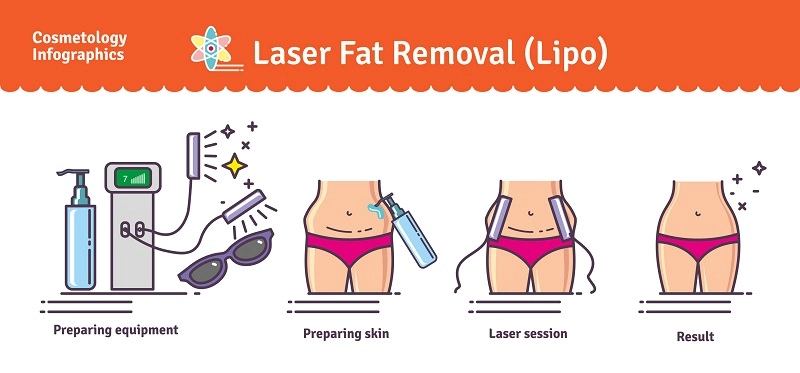
Laser liposuction offers many benefits compared to traditional liposuction techniques. For starters, laser-assisted lipo is less invasive and requires significantly less downtime for recovery than traditional liposuction. It also is more precise than other fat removal methods due to the use of lasers that allow surgeons to target specific areas with precision and accuracy. Patients typically experience minimal discomfort during the procedure and little or no bruising afterward.
The laser used in this type of Liposuction can stimulate collagen production throughout the body, which promotes smoother results and improved skin elasticity. In addition, this procedure may help improve circulation, resulting in healthier-looking skin over time. Lastly, because it involves fewer incisions than regular Liposuction, patients typically have shorter healing times, meaning they can return to normal activities sooner without compromising their safety or comfort levels.
Risks And Possible Complications of Laser Liposuction
Laser liposuction in Los Angeles is an effective fat reduction procedure, but as with any medical intervention, there are risks and possible complications.
Cosmetic surgery carries some risk of adverse reactions to local and general anesthesia. Although rare, patients may suffer from breathing difficulties or an allergic reaction to the drugs used, which could manifest as hives or swelling around the treated area. There is also a small chance of infection at the incision site, usually due to improper aftercare. These issues should be discussed openly with patients before laser liposuction to reduce potential risks.
In addition, it is important to note that even if all safety precautions are taken during the procedure, rare scarring or skin discoloration may occur because of laser exposure. Careful evaluation by trained personnel is essential for minimizing these post-procedure side effects before treatment.
For patients looking for fat transfer for other procedures like a Brazillian butt lift (BBL) or modest breast augmentation, another liposuction method may need to be considered. For harvesting the most healthy fat, the heat from laser lipo is not ideal as it damages the fat. Transferred fat must be healthy enough to establish a new blood supply to stay in the body. In the case of a fat transfer procedure, VASER ultrasound-assisted liposuction is the preferred method.
Schedule Your Laser Liposuction Consultation in Los Angeles
Get transparent pricing, expert guidance, and a personalized treatment plan from Dr. Moein
Who Is Eligible for Laser Liposuction Procedure?
The previous section discussed the risks and potential complications of laser liposuction Los Angeles. While many are ideal candidates for this procedure, certain criteria must be met to ensure a successful outcome:
- Suitable candidates for laser liposuction have small pockets of fat that diet and exercise cannot target and remove. Patients should also be within 30% of their goal weight before undergoing the procedure, as it is not meant as an alternative to significant weight loss but for contouring the body. Patients interested in Liposuction are asked to consider Liposuction when they are at a stable weight. A stable weight requires that you preserve a stable weight that does not fluctuate and one you are comfortable maintaining.
- Patients must not smoke for at least two months before surgery or take medications that could interfere with their healing process. Medications to avoid include blood-thinning medications such as aspirin or ibuprofen.
- Maintain realistic expectations about what the results will look like after surgery. Laser liposuction Los Angeles does not transform one’s figure; it improves optimal body sculpting.
To achieve maximum satisfaction from the procedure, each patient must have clear goals before treatment to understand better what outcomes are achievable through this cosmetic procedure.
Preoperative Preparation for Liposuction
Before undergoing laser liposuction Los Angeles, several steps must be taken to ensure the procedure is safe and successful. It’s important to follow your doctor’s instructions carefully before the surgery. Here are examples of postop instructions:
- Have the prescribed blood work
- Visit your primary doctor to ensure you should have surgery (mainly for extensive procedures)
- Fill prescriptions for pain and antibiotics
- Stop taking certain medications, including aspirin or other blood thinners
- Fast for at least 8 hours before the surgery
- Shower with an antibacterial soap on the day of the procedure
- Wear comfortable clothing on surgery day
- Bring a friend or family member to drive them home
During your consultation visit, discuss all safety protocols with your doctor so you feel informed about what will happen during and after the treatment.
Step-By-Step Process of Liposuction
The treatment begins with a numbing solution injected into the areas to be treated, which reduces discomfort in awake procedures and allows your surgeon to create smoother body contouring. Tiny incisions are made at each site. Through these incisions, a thin tube called a cannula is inserted; this tool works in tandem with specialized laser fibers designed to break down fat cells.
The surgeon then moves the cannula and laser fiber through the fatty tissue to disrupt and dissolve it while simultaneously suctioning it away from the body. Depending on how much fat needs to be removed and what type of results are desired, several passes may need to be performed throughout multiple areas until ideal outcomes are achieved. Afterward, bandages or dressings will be applied over all incision sites before ending the session.
Post-Procedure Care For Liposuction
Immediately following your laser liposuction procedure, you can expect some swelling and bruising, which will subside over the next few weeks. You can manage discomfort or pain in the treated area with over-the-counter medications such as ibuprofen or acetaminophen. If you have more extensive procedures, your doctor may prescribe pain medication. To give you an idea of what to expect:
- You will wear an elastic garment for about four weeks until most of the swelling subsides and while your new shape settles in
- You will be taking antibiotics to prevent infection
- You will avoid strenuous activity or heavy lifting during the healing period
- You will have several appointments with your surgeon for follow-up, including the day after your procedure, to ensure your healing is progressing
- You will need to take off at least one week from work. More if you had other procedures
- As a rule, you can shower within a day or two after your liposuction procedure
Keep all follow-up appointments with your physician so that they can monitor your progress throughout the healing process. It’s important to follow all post-procedure instructions given by your surgeon for recovery time and activity restrictions.
Laser Liposuction Recovery Time
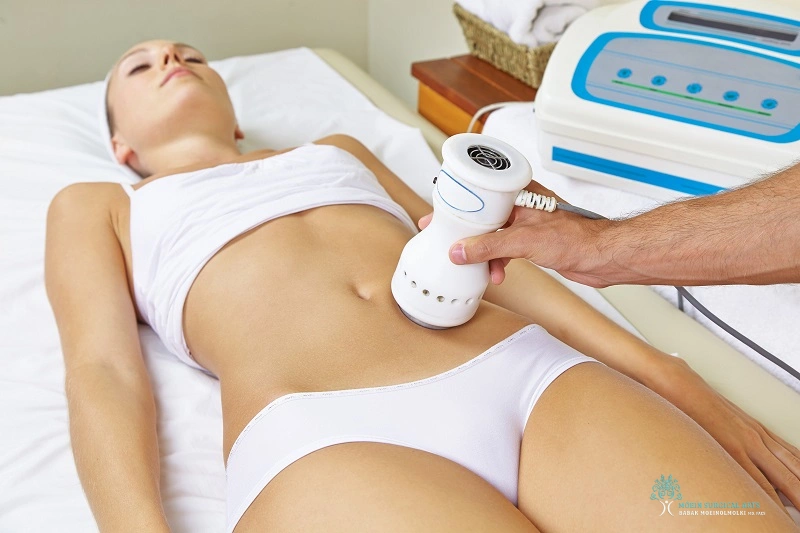
Laser liposuction Los Angeles is a relatively simple procedure that requires minimal recovery time. Patients can expect to return to normal activities within 24-48 hours following the treatment. There is no need for overnight hospital stays or lengthy rest afterward.
The benefit of this minimally invasive technique means patients do not have to deal with the pain and discomfort associated with traditional surgical liposuction techniques. The laser energy breaks down fat cells, which are then naturally removed from the body through lymphatic drainage over the next few weeks after treatment. This process does not require stitches, reducing healing times significantly compared to other techniques. Post-treatment care involves little more than drinking plenty of water and wearing compression garments for support, as your doctor recommends.
Cost of Laser Liposuction Treatment In Los Angeles
The cost of laser liposuction in Los Angeles can differ depending on the type and extent of treatment you require. It is important to consult a qualified physician to discuss your needs and the associated costs. The cost of laser liposuction will depend upon factors such as:
- The size and number of areas treated
- Additional procedures
- The type of anesthesia or medications before the procedure
- The experience and demand for the surgeon
- The area. Cosmetic surgery can be more in large urban areas vs. smaller cities
The surgeon’s fee should also be considered when budgeting for this surgery. Many surgeons offer financing options to help with the cost. With proper planning, patients can ensure they receive quality care while managing their financial responsibilities.
Alternatives To Laser Liposuction
As an alternative to laser liposuction, there are several other options available. These can achieve similar results without undergoing a more invasive procedure.
One such option is tumescent liposuction. This method involves using a saline solution that contains local anesthesia and epinephrine to reduce pain and swelling. The solution is injected into the fat layer beneath the skin before it’s suctioned out with specialized equipment. It carries fewer risks than traditional laser treatment because it does not require general anesthesia or incisions through the skin. Additionally, recovery tends to be fast, allowing patients to return to normal activities soon after the surgery. The downside is there tends to be more soreness and bruising.
Another technique worth considering is VASER ultrasound-assisted lipoplasty (UAL). UAL uses heat created by high-frequency sound waves instead of lasers to break down fat cells before extraction from underneath the skin’s surface. Compared with laser treatments, this approach may provide gentler tissue manipulation, resulting in less trauma and bleeding during and after the procedure and superior fat harvesting. UAL can also target more and larger areas and stubborn pockets of fat located deep within muscle layers and more surface fat. These layers cannot be addressed through laser treatments alone due to safety concerns over potential damage caused by excessive use of thermal energy on surrounding tissues and organs. Because a skilled surgeon can access these layers, muscle etching is possible.
In summary, while laser liposuction offers advantages, many viable alternatives should also be considered when deciding about body contouring procedures, each offering its own set of benefits depending on individual patient needs and preferences.
Conclusion: Laser Liposuction Los Angeles
Laser liposuction is a safe and effective fat reduction in targeted areas. It is important to consult with a board-certified cosmetic or Cosmetic Surgeon specializing in your chosen technique. The patient should be aware of all potential risks and complications associated with laser liposuction before the procedure.
The recovery time varies from person to person; however, most patients can expect to see results within one to two weeks of their treatment, depending on the case’s complexity.
A note from Dr. Moein: I recently treated a patient who was unhappy with her appearance after losing weight through diet and exercise. She underwent laser liposuction Los Angeles, which reduced excess fat from her abdomen, hips, and flanks, resulting in an improved silhouette that she found more pleasing aesthetically. While cost is always a consideration, liposuction provides an excellent option for achieving desired outcomes while minimizing downtime and discomfort compared to other treatments available today.
Ready to Transform Your Body with Laser Liposuction?
Contact Moein Surgical Arts today to schedule your consultation
+1(310)455-8020Proudly serving Los Angeles, Beverly Hills, Santa Monica & Southern California
Board-Certified Cosmetic Surgeon | 20+ Years Experience



